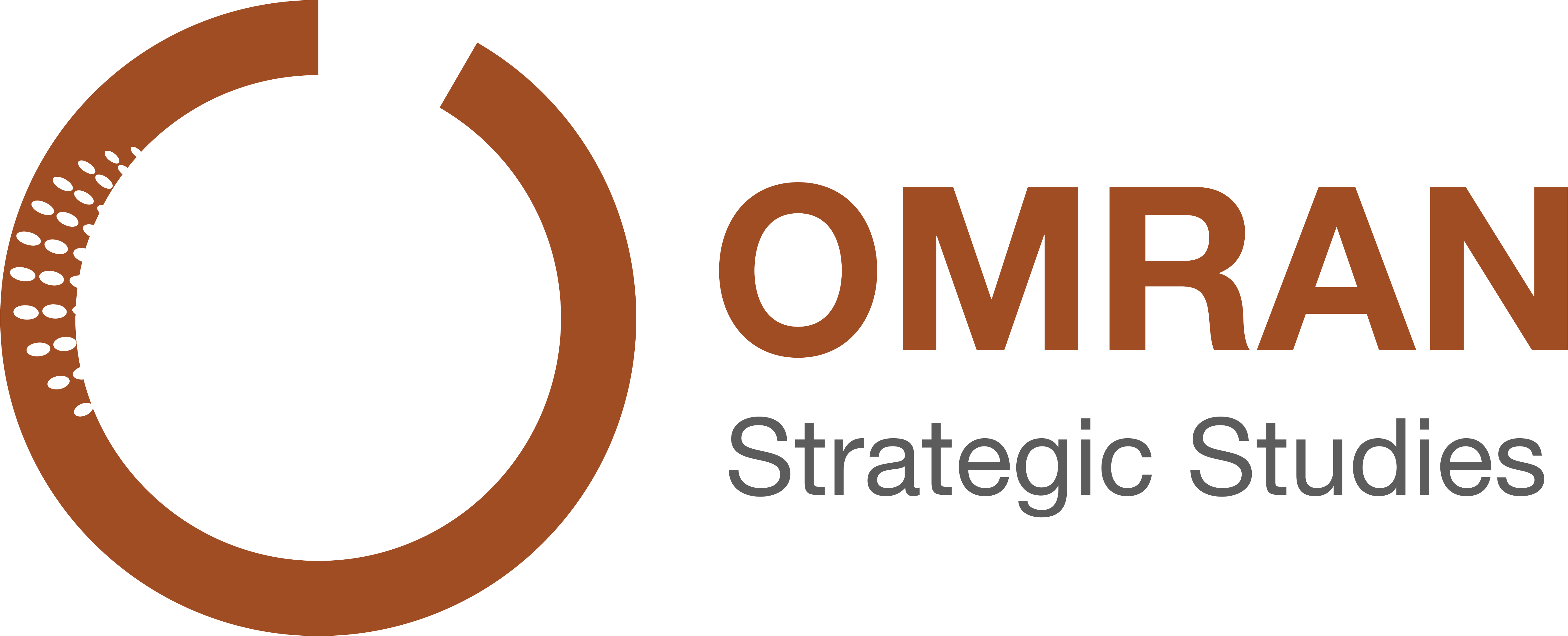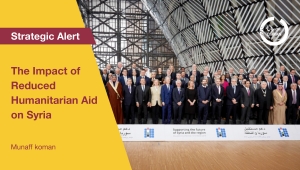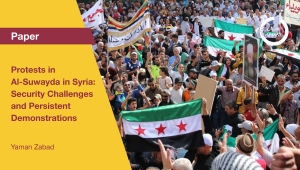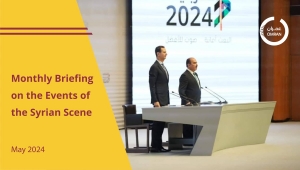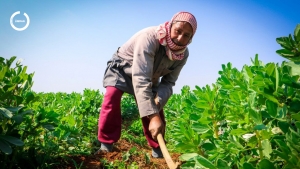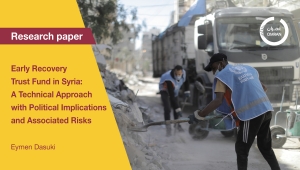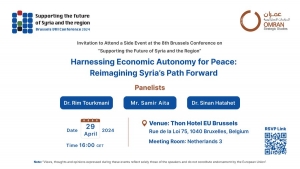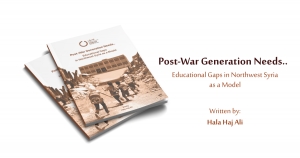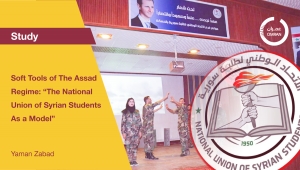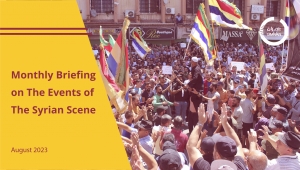Rateb
Monthly Briefing on The Events of The Syrian Scene - June 2024
General Summary
This report provides an overview of the key events in Syria during the month of June 2024, focusing on political, security, and economic developments. It examines the developments at different levels.
- Politically, the normalization steps between Turkey and the Assad regime are progressing. The announcement of local elections by the Autonomous Administration has angered Turkey, increasing its threats.
- Security, violence has escalated across Syria, with 429 civilian and 700 military casualties in the first half of the year.
- Economically, the significant rise in prices continues to be a major issue, alongside increased Iranian influence in the Syrian financial sector.
Turkish Normalization with the Assad Regime: Political Transformations and Future Outcomes
The most discussed topic regarding the Syrian issue is the latest developments in Turkish rapprochement with the Assad regime. Following the Iraqi Prime Minister's statement about creating a basis for dialogue between the regime and Turkey and confirming that talks are ongoing, Turkish statements about upcoming normalization steps followed. The Assad regime has waived its previous condition of Turkish forces' actual withdrawal from Syria to merely declaring their readiness to withdraw and making commitments, according to the regime's Foreign Minister Faisal Mekdad. The Turkish Foreign Minister emphasized the importance of the ceasefire between the regime and the opposition, urging the regime to rationally use this period of calm to resolve its constitutional issues, achieve peace with its opponents, facilitate the return of millions of Syrian refugees, and unite efforts with the opposition to combat terrorism, particularly the Kurdistan Workers' Party (PKK). Russia is intensifying efforts to expedite the normalization steps between the two sides and facilitate a presidential-level meeting between Erdogan and Bashar al-Assad, capitalizing on Turkish concerns about local elections and the entrenchment of the AANES project. Turkey is pursuing a “parallel tracks” policy to improve its relations with Moscow while preparing for the pre-US election period and the potential implications of a Trump administration on the region.
Despite the increased indications of Turkish rapprochement with the Assad regime this month, the normalization process began in late 2022 during quadrilateral talks at the security and intelligence levels under Russian auspices and Iranian participation. These talks went beyond being exceptional meetings to indicate the start of a new normalization path, though initially hindered by preconditions and external interventions. Turkey's insistence on bilateral meetings with the regime without other parties suggests it viewed the Iranian role as obstructive. As for the future of the normalization path, it still requires much time, as the proposed agenda from both sides seems complex and exceeds their capacities. Turkey aims to combat “terrorism” and dismantle the Autonomous Administration project in Northeast Syria, while the regime is unable to achieve this. The AANES 's High Election Commission announced the postponement of municipal elections, originally scheduled for June, to August in response to demands from political parties and alliances. The announcement of the elections faced Turkish rejection and threats to use force to prevent them, considering them a move towards division, as per Turkish statements. The US also declared that conditions are not conducive to conducting transparent and inclusive elections. This indicates that the postponement decision resulted from the lack of US support and serious Turkish threats, prompting local Autonomous Administration supporters to pressure for election cancellation to avoid new military operations. However, setting and then postponing the election date put the Administration in a dilemma, making it appear dependent on Turkish approval for any future entitlements in Northeast Syria. The Administration insists on postponing rather than canceling the elections, while recent Turkish moves toward normalization with the regime primarily target the Autonomous Administration project and open doors to various scenarios for the region's future.
Separately, the Negotiation Commission held its periodic meeting in Geneva, attended by several civil society representatives from within and outside Syria and Arab and European state representatives. The final statement emphasized that UN Security Council Resolution 2254 is the legitimate framework for reaching a sustainable political solution, asserting that Syria is currently unsafe for refugee returns, and rejecting “sham elections” in regime-controlled areas and those planned by the Autonomous Administration.
Increasing Indicators of Violence Escalation in Different Influence Areas
Despite Jordanian understandings with the regime and Arab pressures on the drug trafficking issue, Jordan still faces the threat of smuggling networks. Authorities foiled the largest smuggling attempt in months, seizing 9.5 million Captagon pills and 143 kilograms of hashish intended to be smuggled through Jordan to a third country.
Regarding changes in the regime's military institution, following the cessation of extensive military operations and the regime's involvement in regional communication pathways, the regime seeks internal military structure changes. According to official statements, this aims to discharge reserve service members in three phases by the end of 2025, moving towards reliance on volunteers to build a professional army. Concurrently, the regime's Ministry of Defense issued an administrative order halting the recall of reserve officers aged 40 who have completed two years of service and discharging non-commissioned officers and reserve personnel who have completed six years of service.
In Suwayda, demonstrations against the regime continued, along with a campaign of posters against the People's Assembly elections scheduled for mid-July. The province also witnessed clashes between local armed groups and regime forces, sparked by the regime establishing a new security checkpoint following the abduction of 15 regime members by local groups in response to the regime's arrest of a civil activist.
In North Aleppo, the local council of Al-Bab city announced the opening of the Abu al-Zendin crossing between opposition and regime areas as an official commercial crossing to improve living conditions and enhance local economic activity. This decision coincided with increased indications of Turkish normalization with the regime and aligns with Russian understandings to open trade lines between influence areas. However, reactions varied, with traders and investors viewing it as a vital trade and movement artery and an opportunity to reduce smuggling operations and lower prices due to availability. Conversely, some residents and Syrian National Army members attacked the crossing, damaging some equipment in opposition to its opening, while several entities issued statements demanding civilian management of the crossing outside military faction control, overseen by local institutions responsible for managing the city and establishing mechanisms to secure the crossing economically and security-wise.
This month also saw a significant escalation in ongoing violence in Northeast Syria. The Syrian Observatory for Human Rights documented the killing of 62 people, including 40 civilians, by various means, resulting from 37 acts of violence, including tribal conflicts, murders, about 20 operations by ISIS cells, and Turkish drone strikes. Indicators of violence have also increased across influence areas, with the Syrian Network for Human Rights documenting the killing of 429 civilians in Syria during the first half of 2024, including 65 children, 38 women, and 53 under torture. The highest proportions of victims were in Daraa 27%, Deir Ezzor 18%, and 14% each in Raqqa and Aleppo. The military death toll reached around 700 fighters in different control areas.
Continuous Price Increases Deepen the Economic Crisis
Amid the regime's economic decisions affecting living standards, the requirement for smart cardholders to open bank accounts to transfer support funds is significant. The Council of Ministers stated this step aligns with restructuring support towards targeted and gradual cash support. The regime is expected to abolish current subsidies on bread, fuel, electricity, water, and phone services, shifting the burden to the private sector due to its inability to meet living requirements, leading to significant price hikes and free market sales.
Under Presidential Decree No. 17 of 2024, Bashar al-Assad granted a one-time financial grant of 300,000 SYP (approximately $20) to retirees and government employees, including civil and military workers in the public sector. Given the Syrian pound's devaluation against foreign currencies, the grant is symbolic, covering only a few meals and failing to meet citizens' basic needs.
Clothing prices increased by 200% compared to last year due to rising cotton and yarn prices and the government's lack of intervention to control prices or support the clothing sector. Confectionery prices in Damascus markets also doubled compared to last Eid al-Adha. Despite the arrival of eight Iranian oil tankers loaded with crude oil and gas at Banias port in Tartus countryside, indicating continued Iranian support and sanctions breaches, the regime raised fuel prices amid a local fuel crisis. Due to rising fuel prices and shortages, increased temperatures, and the start of the harvest season, amperage companies in Damascus and its countryside raised kilowatt-hour prices in several areas.
The regime's shift towards export policies, away from self-sufficiency and market regulation, caused price increases. The regime's exports increased by 30% in the first half of this year compared to the same period in 2023. However, the number of Syrian fruit and vegetable trucks exported to Jordan dropped by 80% due to Jordanian restrictions amid anti-drug smuggling efforts.
Iran continues to expand its influence in the Syrian financial sector by opening institutions and banks. The Islamic City Bank, jointly owned by Iran and Syria with a capital of 50 billion SYP, recently opened, making it the fifth Islamic bank in Syria. Meanwhile, Russian tourism investors supervised the construction of two tourism facilities in Latakia province, with 50% completion. The number of Russian visitors to Syria reached 780,000 by the end of May, a 10% increase from the same period last year.
In Northeast Syria, the AANES published the 2024 budget details, with total revenues of $670 million and expenditures of $1.059 billion, indicating a projected $389 million deficit. Turkish airstrikes on SDF economic hubs, including energy infrastructure, caused estimated losses exceeding $500 million, contributing to economic paralysis. Given the estimated $1 billion expenditures, the region continues to face living crises at all levels, including rising prices, material shortages, and poor public services. Meanwhile, the SDF began delivering the first batch of wheat procured from Northeast Syria farmers to regime grain collection centers in southern Qamishli, transporting over 2,500 tons of wheat in 24 hours.
In North Aleppo, the Syrian-Turkish Energy Company raised household and industrial electricity prices to 3.6 and 4.1 Turkish liras per kilowatt, respectively, citing changes in Turkish electricity prices. The Syrian Interim Government set wheat prices in its areas at $220 per ton, $110 less than last season and the lowest price among influence areas: $310 per ton in Idlib and Northeast Syria and $360 in regime areas. This price is disproportionate to farmers' production costs. In Idlib, the “Salvation Government” reiterated financial transfer delivery regulations in the sent currency to organize the financial market, increase trust, and enhance control over financial policies and price regulation, reducing the need for black market currency conversions.
The Impact of Reduced Humanitarian Aid on Syria
Introduction
Due to the escalating crises and conflicts worldwide, the growing number of individuals requiring relief and humanitarian assistance, and the significant disparity between needs and resources(1),Syrians face complex challenges and responsibilities amidst political deadlocks. This situation necessitates an awareness of the implications for the level of services provided and the number of beneficiaries within Syria, considering the deteriorating social and economic conditions for Syrians in host countries.(2)
According to the Global Humanitarian Overview report issued by OCHA for 2024, approximately 308 million people worldwide require humanitarian assistance, necessitating $48.64 billion to aid 187.8 million people in 70 countries through 36 coordinated response plans. Only 15.3% of the plan has been funded so far, with $7.42 billion in funding, which is 35% less than the $11.40 billion recorded during the same period last year. Additionally, the total reported funding amounted to $4.34 billion, which is 42% less than in 2023 ($7.44 billion). Reported funding from major donors in the first four months of 2024 has also decreased compared to 2023.
Local and Regional Implications
This reduction will have several implications for Syria on the local level, such as worsening living conditions, increased migration waves, heightened militia activity, the growth of the war economy, and involvement in illicit activities such as drug and arms trafficking. Additionally, societal violence, including theft, kidnapping, and extortion, will negatively impact local security and stability indicators.
On the regional level, economic pressures on host countries will increase, leading to a higher likelihood of these countries pushing Syrian refugees to return voluntarily or forcefully and taking measures to tighten restrictions on them. Additionally, the risk of drug trafficking in neighboring countries (Lebanon, Jordan, Turkey, Iraq) may increase, using their territories as transit points to the Gulf and Europe.
Syrian actors in the relief and development field will face several direct challenges, including:
- Severe Food Security Crisis: The reduction in humanitarian funding since 2023 to $2.1 billion (39% of needs) led the World Food Program (WFP) in mid-2023 to reduce the number of people receiving aid from 5.5 million to 3.2 million (a 40% reduction) starting in July 2023. The program announced the cessation of its general food aid across Syria in January 2024 due to severe funding shortages, marking the seventh and largest reduction since the program began its work in Syria.
- Increased Needs: According to United Nations estimates, around 16.7 million people need humanitarian assistance, up from 15.3 million in 2023, the highest number since 2011. Among them, 7.2 million people are internally displaced in scattered areas, including 2.05 million in overcrowded camps.
- Severe Funding Shortages: Only 8% of the required funds have been received, with $358 million collected out of the $4.07 billion needed by May 2024 to meet the immediate humanitarian needs of 10.8 million targeted individuals. Many local organizations in northwestern Syria have had to halt numerous service programs, lay off dozens of employees, and close offices in various towns and cities in the countryside of Aleppo and Idlib.
The following table shows the gradual increase in people in need of humanitarian assistance between 2018 and 2024, in contrast to the decrease in the percentage of funding received compared to the required funding, from 62% in 2018 to 39% last year and 8% this year:

Increased Pressure on Services in Host Countries: It is expected that more than 19 million people will need assistance in 2024, including about 6.4 million refugees and 12.9 million affected members of the host community. Due to reduced funding and the need to prioritize strategically, the collective funding request for 2024 has been reduced to $4.1 billion compared to $5.8 billion in 2023 after reviewing requirements based on priority needs. As a result of the increasing funding crisis, the number of Syrian refugee families in Lebanon receiving cash assistance has been reduced to about one-third in 2024. The World Food Program in Jordan announced a reduction in its monthly food aid to 465,000 refugees in mid-July 2023 and excluded about 50,000 others from monthly assistance due to funding shortages.
The following table shows the increase in people in need of humanitarian assistance in the five host countries (Lebanon, Jordan, Egypt, Iraq, and Turkey) against the decrease in coverage between the required amount and the paid amount.
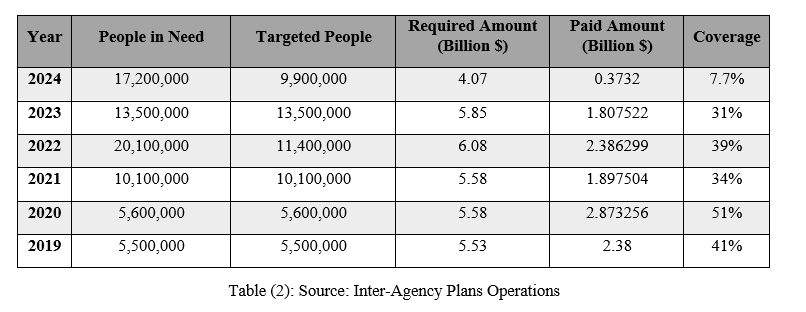
Deterioration of Services (Water, Sanitation, Care, Electricity, Education): The deteriorating services for displaced individuals in collective centers will increase the risk of resorting to negative coping strategies. About 2.3 million women of reproductive age, including 500,000 pregnant and lactating women, will lose access to essential reproductive and maternal healthcare. Additionally, 2.5 million out-of-school children will miss the opportunity to return to school, threatening the future of an entire generation and depriving children of their basic right to education(3).
Strategic Recommendations
Despite donor pledges during the eighth Brussels Conference for "Supporting the Future of Syria and the Region" amounting to €7.5 billion ($8.1 billion), with $3.8 billion allocated for 2024 and $1.3 billion for 2025, the importance of addressing the potential for funding cuts and reduced aid remains significant. Syrian actors in the political, humanitarian, and developmental sectors must urgently address this challenge through several policies:
- Operational Alliances: These alliances ensure organizational independence while enhancing cooperation and coordination for effective project execution, preventing activity and project duplication.
- Syrian-Designed Comprehensive Response and Recovery Plan: Syrian actors should develop a comprehensive plan as a reference for response and recovery priorities, updated annually.
- Multi-Dimensional Advocacy Policies: Alongside traditional advocacy, innovative advocacy through coalitions can enhance benefits and broaden advocacy efforts both geographically and sectorally.
- Economic Empowerment Policies: Develop statistical and information collection tools, support small and medium-sized projects, and provide vocational training to create job opportunities, thereby reducing dependence on external aid. Implement basic infrastructure projects (water, sanitation, electricity, health, education) to enhance economic recovery and improve living conditions.
Conclusion
International involvement is crucial in Syria's response and recovery efforts. However, the capabilities, networks, and experience of Syrian actors can drive the development of an executive vision for the region's requirements, transitioning them from implementers to planners and implementers simultaneously.
([1]) The disparity between needs and requirements reached an unprecedented level of $31 billion by the end of 2023, with a total paid amount of $24.28 billion, or 43% of the required amount estimated at approximately $56 billion.
([2]) The year 2023 ended laden with significant difficulties and challenges faced by the world, starting with the earthquake that struck Syria and Turkey in February, followed by the conflict in Sudan in April, which left 30 million people in need. Additionally, the Israeli aggression on Gaza resulted in the deadliest humanitarian crisis in the sector since the Rwandan genocide in 1994. Alongside all these crises, conflicts continued in Syria, Ukraine, Afghanistan, Yemen, Congo, Haiti, and other regions.
([3]) Resident Coordinator and Humanitarian Coordinator Mr. Adam Abdelmoula Press Briefing on the humanitarian situation in Syria, 22-03-2024. Link: https://2u.pw/EGrZ56mr
Protests in Al-Suwayda in Syria: Security Challenges and Persistent Demonstrations
Executive Summary
- The uprising in Al-Suwayda Governorate reached its eighth month by April 2024, advocating for economic improvements and political transition in Syria through the implementation of UN Security Council Resolution 2254. The protests called for the overthrow of the regime and the removal of its security hold over the city, including demands to shut down Ba'ath Party headquarters. The extent of the protests has fluctuated, expanding, and contracting in response to shifts in the dynamics of the movement in Al-Suwayda and the varying positions of spiritual and religious authorities after the first month. The three religious’ leaders, Hikmat Al-Hijri, Hamoud Al-Hannawi, and Yousef Al-Jarbou, unanimously agreed on the necessity of economic reforms. However, Sheikh Yousef Al-Jarbou's stance more closely aligned with the Assad regime's narrative in the governorate. He also led the Druze religious authority during regime events, coinciding with his regular meetings with leaders of several militias opposing the movement in the governorate.
- The protests peaked in August 2023 but gradually subsided, eventually concentrating in Karama Square in Al-Suwayda and the towns of Al-Qrayya and Salkhad. The decline can be attributed to the shift of people from the rural areas of the city towards the main squares to intensify the gatherings. Additionally, militias active in the eastern and western rural areas of the governorate resumed their involvement in drug trafficking to the Jordanian borders. These militias have threatened the movement several times, fearing that the protests might threaten their trade or that they might later be targeted by the protesters themselves.
- The disagreement among the political factions in the governorate manifested in the proposed administrative structure of Al-Suwayda. All political factions in the governorate agreed on the necessity of economic reforms. However, the suggestion by the Syrian Brigade Party and Syrian Federal Movement to federalize Al-Suwayda was a point of contention for the other factions, who viewed it as an attempt to impose a political vision on the movement that would lead to a partial political solution not encompassing other Syrian provinces.
- The anticipated scenarios for the movement fall within three main axes: The first is the proposal by the Syrian Brigade Party to implement federalization in Al-Suwayda as an administrative solution for the governorate. This solution is seen as a threat to the movement because it is associated with the experience of the Syrian Democratic Forces (SDF) in Northeast Syria, which opened a confrontation front with the Turkish government, as it threatens Turkish national security. Additionally, the movement is regarded as another separatist attempt in southern Syria, giving the Assad regime a pretext to use violence in the governorate. The second scenario involves the movement's ability to create shared spaces either with other regions, aiming to align local demands with national demands that extend beyond the geography of the provinces outside regime control, or even to initiate dialogue with neighboring countries concerning their security concerns, such as the production and smuggling of Captagon, particularly concerning Jordan. The third scenario sees the regime continuing to operate on a no solution basis while the effectiveness of Captagon smuggling routes in the governorate continues. This, combined with the lack of expansion of the movement, might prompt militias involved in the trade to destabilize the city's security if the movement becomes a threat to their smuggling operations.
Introduction
The uprising in Al-Suwayda Governorate continued into its eighth month by April 2024, demanding economic improvements and political transition in Syria through the implementation of Resolution 2254. The protests have called for the overthrow of the regime and an end to its security grip on the city, including demands to close the Ba'ath Party headquarters. This paper aims to examine the events in Al-Suwayda from July 2023 to March 2024, analyze the map of actors influencing the movement, understand its extension and response to security changes in the region, evaluate the role of religious authorities, and explore future directions for the field scenario in Al-Suwayda.
Changing Intensity of Protests and Multiple Factors
Since the beginning of the uprising, the extent of the protests in Al-Suwayda has varied, influenced by changing security and field events that the movement has undergone. Additionally, the varying stances of the spiritual authorities after the first month have influenced some of the movement's demands. These authorities have unanimously agreed on the necessity of economic reforms in the governorate, while their positions on the political demands related to political reform and the implementation of Resolution 2254 have differed.
Sheikh Youssef Al-Jarbou's position has closely aligned with the regime's narrative in the governorate(1). He criticized the political demands of the demonstrators as incorrect and led the Druze religious authority during the regime’s events and activities from August 2023 to February 2024. On October 12, 2023, he participated in the morning of the martyrs of the Military College in Homs.(2) Sheikh Youssef also held frequent meetings with Safwan Abu Saad, the governor of the Damascus countryside, who is originally from Suwayda, and dealt with local militias that posed a threat to the movement and protesters in the city. His dealings with the leaders of the Saif al-Haq militia, Radwan and Muhannad Mazhar, who were heavily involved in drug trafficking and security unrest, were of particular importance(3).
While Sheikhs Hamoud Al-Hannawi and Hikmat Al-Hijri's positions were closer to the popular movement, they varied in their opposition to the regime's authority in the governorate. Sheikh Hamoud Al-Hannawi participated in several protests and supported the public demands, urging people to demand their rights in a clear and bold voice. Meanwhile, Sheikh Hikmat Al-Hijri remained committed to his narrative that the political and economic demands of the protesters must be met, alongside his calls for local factions to protect the movement, thereby preserving civil peace and preventing the protests from turning into violent conflicts between the protesters and the regime forces in Al-Suwayda. The divergence in the positions of religious authorities, on the one hand, and the Assad regime's choice of a no-solution strategy, relying on time to diminish the movement after the protests failed to expand beyond Al-Suwayda to Daraa or other regime-controlled cities, on the other hand, led to a shift in the momentum of the protests in terms of number and spread across the villages of the governorate.
Figure (1) shows that the protests peaked in August 2023, after which the protest sites gradually receded to concentrate mainly in Karama Square in Al-Suwayda and the towns of Al-Qrayya and Salkhad. The decline is attributed to people moving from the rural areas of the city towards the main squares to intensify gatherings, especially on Fridays. Additionally, militias active in the eastern and western rural areas of the governorate returned to their activities in drug trafficking and its transfer to the Jordanian borders. These militias have threatened the movement several times, fearing that the protests might jeopardize their trade or that they might later be targeted by the demonstrators themselves.
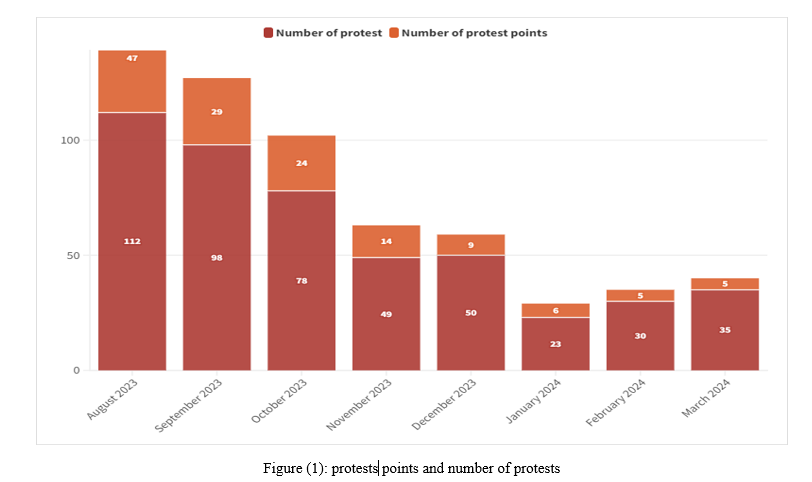
Efforts to Organize the Movement and the Interwoven Demands
Some community elements in Al-Suwayda began organizing themselves into political entities with the onset of the Syrian revolution in 2011, but most remained inactive due to the specific conditions imposed by the city on Assad's regime behavior towards it. The regime avoided direct confrontation with local factions or religious authorities to ensure that a southern opposition pocket comprising Al-Suwayda, Daraa, and Al-Qunaitra did not form against it. Additionally, these entities did not join the traditional opposition represented initially by the Syrian National Council and later by the Syrian Coalition. However, as the movement in Al-Suwayda crystallized over several waves, the longest of which began in August 2023, some political components in the governorate became more active, and their demands became clearer, organized around three axes: the administrative structure of the governorate and its relationship with the central authority in Damascus, the nature of the required political reforms, and the extent to which the demands align with those of the 2011 revolution and international resolutions, especially Resolution 2254, which mandates a political transition in Syria.
Table (1) illustrates the key political actors in the governorate and their positions on the previously mentioned axes. It shows a consensus among political entities on the necessity of political transition, affirming that the popular movement in the governorate is part of the broader narrative of the 2011 popular movement with similar political and economic demands. However, the political disagreement among these components lies in their divergent views on Al-Suwayda's role within Syria's governance structure. The Syrian Brigade Party, established in 2021, believes that federalization is the most effective solution for political reform in Syria. This view is supported by several local political currents in the governorate, along with the Syrian Democratic Council (SDC) based in Northeast Syria, which welcomes the proposal. This proposal aligns with their broader vision of implementing a federal solution in Syria and exporting it to other regions like Al-Suwayda, thus potentially strengthening the SDC narrative if it can export its model to other areas with unique ethnic or racial characteristics. (4)

The popular movement has sustained its demands for political change and necessary economic reforms, alongside efforts to disassociate the Ba'ath Party from the state apparatus in the governorate. Protesters have moved towards permanently closing the party's headquarters or even converting some into public service facilities. This is juxtaposed with a strong emphasis on the need to protect state service institutions, which should remain neutral and not become entangled or influenced by the ongoing protests.
Protesters have closed several Ba'ath Party headquarters in Al-Suwayda city and its countryside, totaling 27 headquarters by the beginning of March 2024. Ten of these were transformed into service centers for the citizens of the governorate(5)In response, the Assad regime maintained its narrative that the presence of the party's headquarters is linked to the presence of service institutions in the city, which led it to reduce the operational capacity of its service institutions as a reaction to the closure of the party's headquarters. As the popular movement continued, demonstrators gathered in front of some service institutions and closed some of them in protest against their nominal and ineffective role in the governorate(6).
Regarding the stance of political actors in the movement, they attempted to protect state institutions, emphasizing their neutrality, and ensuring they were not targeted. However, some political currents sought to create alternative service and security bodies in the city. The Syrian Brigade Party initially established a Counter-Terrorism Force led by Samer Al-Hakim, but this initiative was met with a security campaign by the regime's Military Security, which resulted in the disbanding of the force and the killing of Al-Hakim in June 2023. Subsequently, the party announced the establishment of several service offices such as a water authority, a rapid medical intervention office, and civil defense. These establishments were part of the Brigade's efforts to introduce the concept of self-administration to the movement, capitalizing on the service vacuum left by the regime's absence in the city. However, the idea of these institutions did not gain popularity among other political currents due to their rejection of a partial political solution limited to Al-Suwayda rather than extending to other Syrian provinces.
Local Scenarios within a Turbulent Regional Environment
Since its inception, the Al-Suwayda movement has been closely tied to rapidly changing regional dynamics, manifesting in three main areas: first, the trade and production of Captagon; second, the normalization process with the Assad regime; and third, the presence of Iranian forces in Syria and the increasing frequency of Israeli attacks on these forces. Future regional changes could also influence the expansion or contraction of the movement based on the positions of neighboring countries regarding the proposed scenarios. On the local level, the potential scenarios include three possibilities: the risks associated with proposing self-governance, the movement's ability to open new spaces for cooperation both internally and externally, and the potential for the movement to be dominated and redirected.
· The First Scenario involves the Syrian Brigade Party's proposal for federalism in the city, which poses a risk to the movement by associating it with the SDF experience in Northeast Syria, which has opened a confrontation front with the Turkish government. This proposal also raises fears that the movement could be viewed as another separatist attempt in Syria, similar to the SDF's demands for an independent area, thereby strengthening its international stance in advocating for turning Syria into federations. This scenario would provide the Assad regime with a pretext to use violence in the province to assert control over Al-Suwayda under the guise of protecting Syrian territorial integrity. Previously, the Assad regime had no clear justification for using violence against the movement due to the unique demographic composition of the city and its reliance on two elements for the movement's decline. The first is linked to local groups causing security disturbances, and the second bets on time for the movement's recession and cessation if the demonstrators fail to form political forces or establish a national coordinating framework among all regions outside Assad's control.
· The Second Scenario entails the movement's ability to create shared spaces with other areas, aiming to align local demands with national demands that transcend the geography of the provinces outside regime control. This could involve transforming economic and political demands into a unified discourse, potentially revitalizing the political process, or even initiating dialogue with neighboring countries to address their concerns. An example of this is reassuring Jordan, which considers the smuggling of Captagon from Syrian territories as one of the most significant threats to its national security and is seeking solutions to halt its flow across its borders.
· The Third Scenario is based on the regime's reliance on a no-solution approach, while the effectiveness of Captagon smuggling routes continues in the province. With the Al-Suwayda movement not expanding beyond the governorate, local militias linked to the regime and Iran might destabilize the city's security if the movement threatens their smuggling operations. These militias are integral parts of the Captagon supply, production, and smuggling chains.
In conclusion, it is not possible to definitively predict one scenario over others without considering international variables, such as the war on Gaza and the ongoing Israeli raids on Iranian positions in Syria, as well as the perspectives of local political currents on the future of the movement and the city. The proposal for federalization within the movement would face Turkish opposition to prevent the Al-Suwayda movement from becoming a lever that the SDF might later exploit. Additionally, the way Jordan handles the Captagon issue and its potential coordination with local factions like the Men of Dignity Movement (Rijal Al-Karama) could protect the movement and open up other cooperative prospects with Jordan, potentially having economic or political dimensions in later stages. The challenge for the movement's coordinators and local factions remains in their ability to present a political front that reflects their demands and is consistent with the broader Syrian context, particularly as regional countries shift their focus in Syria to security motivations after previously supporting the movement and its political demands.
([1]) Contrary to Druze references: Sheikh Yousef Jarbou confirms his alignment with the Syrian regime, Al-Quds Al-Arabi, 30/08/2023, https://bit.ly/3J4naBg
([2]) Yousef Jarbou in Homs to condole the regime for the casualties of the "Military College," Al-Souria Net, 12/10/2023, https://bit.ly/4cHbGRR
([3])Suwayda: Groups linked to Military Security threaten to suppress the movement, Al-Madina, 09/11/2024, https://bit.ly/3vWaM3q
([4]) SDC supports the demands of Al-Suwayda protesters for self-administration and holds the Syrian government responsible for the deteriorating conditions, Al-Yawm TV, 21/08/2023, https://bit.ly/4aKKa4C
([5]) The pages of political currents, Al-Suwayda 24 page, and several local news networks were monitored, and data was cross-referenced among them during the period from August 2023 to March 2024.
([6])Protesters shut down several government departments and institutions, including the Directorate of Telecommunications and the Directorate of Agriculture, in protest against "the lack of response from government bodies to the demands of the citizens in Suwayda," Al-Suwayda 24 Facebook page, 05/11/2023, https://bit.ly/4aGTqpV
Monthly Briefing on The Events of The Syrian Scene
General Summary
This report provides an overview of the key events in Syria during the month of May 2024, focusing on political, security, and economic developments. It examines the developments at different levels.
- Politically, the trajectory of Arab normalization with the Assad regime remains volatile. The Arab League summit's statement and the suspension of the Arab Contact Committee reveal a more cautious Arab stance towards opening up to the Assad regime. Meanwhile, diplomatic normalization appears more stable, evidenced by Saudi Arabia appointing an ambassador to Damascus.
- Security, instability persists across Syria due to the Iranian-Israeli proxy war on Syrian soil and the presence of various militias in regime-controlled areas, along with local actor conflicts and their unstable models.
- Economically, all regions in Syria are suffering from an economic crisis exacerbated by the decisions of controlling authorities, with attempts to boost investment in northern Syria.
The Path of Arab Normalization with the Assad Regime: Challenges and Limited Progress
The path of Arab normalization with the Assad regime faces significant difficulties and challenges that the intervening parties struggle to address. Notably, the Arab Liaison Committee's meeting, intended to communicate with the regime, was canceled after Damascus failed to respond to inquiries regarding Captagon smuggling and other issues. Additionally, a meeting between the regime's foreign minister and his Jordanian counterpart, Ayman Safadi, yielded no progress on the Arab Committee's requests.
Despite Bashar al-Assad's attendance at the regular Arab summit held in Bahrain, without a scheduled speech, the final statement emphasized the necessity of resolving the Syrian crisis in accordance with Resolution 2254. This includes the transition process, ensuring Syria's security, sovereignty, and territorial integrity, fulfilling the aspirations of its people, eradicating terrorism, and providing a dignified and safe environment for the voluntary return of refugees. Reflecting the limited Arab openness, the Assad regime ceded hosting the next summit to Iraq. These developments indicate a more cautious and deliberate Arab approach to normalization with the Assad regime, reassessing the implications of opening up further in light of growing concerns that additional incentives to Assad could yield counterproductive results.
Locally, within the context of formal structural changes initiated by the regime, Bashar al-Assad participated in the expanded meeting of the Central Committee of the Arab Socialist Baath Party. The meeting resulted in Assad's re-election as Secretary-General of the party and the election of 14 new members to the central leadership. Additionally, members of the party's Central Committee at the provincial level and the new Control and Inspection Committee were elected. However, these changes are merely organizational adjustments within the party's structure, aimed at recycling the regime's allies to maintain the Baath Party's control over Syria's political and social landscape. These steps do not seem to contribute to genuine reforms that could satisfy Syrian parties and lead to a comprehensive political solution.
In northeastern Syria, the Autonomous Administration is making efforts to fortify the home front ahead of the municipal elections scheduled for the first half of July. Mazloum Abdi, the commander-in-chief of the SDF, held a series of meetings with Arab tribal sheikhs and notables in Deir Ezzor, where he acknowledged mistakes made by his forces during the pursuit of ISIS elements and pledged to release detainees and compensate those affected. This coincides with the issuance of the Autonomous Administration law on administrative divisions in preparation for local elections. The announcement of these elections has sparked significant controversy locally, regionally, and internationally. The US State Department stated that the conditions for free and fair elections in northeastern Syria are not met, while Turkey considers these elections a threat to its territorial integrity and national security. Under the new Administrative Divisions Law, northeastern Syria is now considered a single region divided into seven main districts. These laws and procedures are part of the administration's attempts to gain legal legitimacy over the region and establish a new status quo for future negotiations with other conflict parties in Syria. Additionally, these steps send messages to achieve political and field gains, raising concerns about the social, political, and legal consequences for Syrians residing in areas under the administration's control and the future of Syria in general.
Escalating Security Challenges in Syria
The security dilemma in Syria continues to worsen, with the country serving as a battleground for the Iranian-Israeli conflict. Israeli aircraft have targeted sites of Iranian militias in southern Damascus, Daraa, and Qusayr in Homs province, as well as a building managed by the regime's security forces on the outskirts of Damascus. These raids resulted in the deaths of 11 militiamen, including Syrians and Lebanese. In contrast, the "Islamic Resistance in Iraq" of the Iranian Revolutionary Guards carried out seven attacks targeting Israeli military sites in the occupied Syrian Golan. Additionally, an explosive device detonated in Damascus' Mezzeh neighborhood, killing one-person, injuring others, and burning cars. This marks the second such explosion in the same area within two months. In southern Syria, assassinations and clashes persist. Two regime forces members were killed by explosive devices planted in their cars north of Daraa. The regime has launched repeated security campaigns in the province, ostensibly to pursue wanted individuals involved in targeted attacks. However, mutual targeting and assassinations continue, affecting regime forces and former opposition fighters. These security policies have failed to establish stability in southern Syria. Meanwhile, weekly demonstrations in as-Suwayda persist despite the regime's attempts to intimidate protesters by sending large military reinforcements.
In Idlib, popular protests against Hay'at Tahrir al-Sham (HTS) have escalated. HTS's attempts to peacefully contain these protests by promising reforms have failed. This month, HTS forcibly dispersed a sit-in in central Idlib, with security elements assaulting protesters with hands and batons. Abu Muhammad al-Julani, HTS's commander-in-chief, justified this action by stating that HTS had warned against any disruption to public interests and rules, considering most of the protesters' demands as already met. HTS's failure to end the protests peacefully has led to the use of force in an attempt to intimidate protesters, though they seek to avoid excessive violence to prevent expanding the protest area and gaining new supporters who have remained neutral.
In northeast Syria, Turkish artillery targeted several villages near the town of Tal Tamr in al-Hasaka countryside, and the shelling extended to villages in the countryside of Manbij city. In Deir Ezzor, the SDF conducted a security screening campaign in various areas and bombed several towns and villages west of the Euphrates River under the control of regime forces and Iranian militias, resulting in civilian injuries. Additionally, the SDF launched a security operation in the city of al-Busaira, east of Deir Ezzor, which led to the death of an Iraqi ISIS leader. The number of ISIS operations in the area has declined, coinciding with increased security measures and reinforced military checkpoints.
Attacks by tribal fighters on SDF headquarters and checkpoints in Deir Ezzor also decreased significantly during the second half of May 2024. This decrease followed heavy shelling by the SDF on villages and towns near the city of Mayadeen, believed to be a haven and staging point for tribal fighters. The SDF's strategy in dealing with tribal fighters appears to have two main approaches. Locally, the SDF is attempting to re-engage with Arab tribes by increasing the frequency of meetings between SDF leaders and tribal notables, providing incentives to tribal leaders, and promising to improve services in the region. From a security perspective, the SDF is pressuring pro-regime forces and tribal fighters by bombing their gathering places and launching operations south and west of the Euphrates to incite local populations against them and increase the regime's burden in containing these fighters.
Economic Empowerment Initiatives and Challenges in Northern Syria
To highlight new patterns of humanitarian intervention and opportunities for social and economic empowerment, Syrian, Arab, and international organizations held a conference aimed at enabling investment in northern Syria. The conference recommended forming working groups to visit UN and international donor organizations and establishing an economic empowerment fund.
In northeastern Syria, the Autonomous Administration raised fuel prices: the price of diesel for agriculture reached /1,050/ SYP, heating diesel reached /1,150/ SYP, and a jar of domestic gas rose to /153,000/ SYP. Additionally, the price of a bread bundle increased from /900/ to /1,400/ SYP after the price of flour sold from mills to ovens was raised in all regions of northern and eastern Syria. In Manbij, the People's Municipality completed the first phase of equipping the industrial city, the largest of its kind in northern and eastern Syria, which will include shops and factories for the food, wood, and metal industries. The Autonomous Administration also concluded a deal with the Assad regime, obliging the supply of half a million tons of wheat at /36/ US cents per kilogram, while the administration priced the purchase of wheat from local farmers at /31/ US cents per kilogram. This deal is expected to yield financial gains for both parties: the regime will acquire wheat without incurring supply and storage costs, and the Autonomous Administration will achieve a profit rate of at least /3/ cents per kilogram of wheat, securing funds to cover the salaries of its civil and military employees.
Meanwhile, the regime government raised fuel prices: gasoline octane 90 reached /12,500/ SYP per liter, octane 95 rose to /14,368/ SYP per liter, and free diesel reached /11,996/ SYP per liter. The Economic Committee of the Presidency of the Council of Ministers called for a tax of /$25/ per imported solar panel. The Ministry of Internal Trade imposed new taxes on imported items, including white sugar and solar panels. Prices of commodities, vegetables, and fruits in Damascus increased by /70%/ compared to the same period last year, yet the regime resumed exporting vegetables and fruits to Gulf countries. The decisions to raise fuel prices and increase taxes have driven up consumer goods prices amid low purchasing power and a deteriorating economic situation, with many families relying on cash transfers from relatives abroad to meet basic living needs.
At the 8th Brussels conference, donor countries pledged /€7.5/ billion in donations, grants, and loans: /$3.8/ billion for 2024 and /$1.3/ billion for 2025. However, concerns about potential funding cuts and reduced aid highlight the urgent need for actors in political, humanitarian, relief, and development sectors to address these challenges through policies focused on economic empowerment and developing response and recovery plans aligned with new challenges.
Indicators of Early Economic Recovery in NW Syria in 2023
Executive Summary
- Throughout 2023, northwestern Syria, particularly Aleppo and Idlib provinces, witnessed the implementation of 5,178 projects. The finance sector was in the lead registering 2,914 projects, followed by 413 projects in social services sector. The electricity sector accounted for 357 projects, transportation and communications for 338 projects, and water and sanitation services for 327 projects.
- Approximately 68% of these projects were conducted in rural Aleppo. Atarib was the most active locality, followed by Jarablus with 661 projects, and Idlib with 636 projects.
- Following the catastrophic earthquake that struck Syria and Turkey on February 6, 2023, local councils and organizations swiftly moved beyond the initial shock. They managed to carry out diverse projects across various sectors, demonstrating the resilience of the local community in challenging circumstances.
- Efforts were focused on social services and internal displacement sectors to address the earthquake's impact and meet the needs of displaced populations. This included reconstructing schools and hospitals and establishing new facilities to improve living conditions and integrate displaced individuals into new communities.
- The agriculture and livestock sector continues to face significant challenges due to drought, rising cost of raw materials, and the migration of farmers. These issues make agricultural activities non-viable, reduce productivity, and threaten food security.
- The industrial sector faces numerous challenges, including the lack of essential legal documents such as establishment certificates, customs declarations, and health certificates. Additionally, high raw material and energy costs, along with marketing obstacles, further complicate the situation.
- The report proposes several measures and recommendations, including expanding efforts in the finance sector by supporting medium-scale and innovative projects that can drive production, generate employment opportunities, and increase income levels. It advocates for reduced electricity rates for factories to enhance the resilience and competitiveness of local products. Furthermore, it suggests offering financial and material incentives to manufacturers, removing marketing barriers, and broadening access to financial systems to stimulate industrial production and commercial activity.
The report faces a series of technical and research challenges, such as intermittent military tensions in Idlib and rural Aleppo, which directly threaten the "early recovery" process by delaying or halting project implementation. The absence of a statistical institution capable of collecting and organizing necessary data and providing accurate figures forces researchers to rely on monitoring activities conducted by organizations and local councils, a method that may lead to discrepancies in evaluating the recovery level.
Additionally, researchers encounter challenges due to the lack of comprehensive documentation of all activities by local councils and organizations on their official platforms due to security reasons. Moreover, there is a complete absence of data covering the private sector’s activities in the area, adding complexity to understanding and evaluating the full economic situation. It is also worth mentioning the ongoing controversy surrounding the funding of early recovery activities by the international community, which perceives such funding as potentially empowering the regime and contributing to reconstruction efforts. This could lead to the regime exploiting international recovery funds and politicizing them. Furthermore, there is a notable deficiency in international funding for recovery compared to funding for humanitarian needs.
This report defines "early recovery" based on several periodic reports by Omran Center since 2019. The concept refers to the efforts and projects conducted by governance bodies and non-governmental organizations aimed at rebuilding and enhancing economic and social capacities in the aftermath of a conflict. It helps bridge the gap between the humanitarian aid phase and the reconstruction phase, all in pursuit of achieving sustainable stability in a fragmented society and reducing dependency on external assistance.
A Comprehensive View of Achievements in 2023
In 2023, northwestern Aleppo and Idlib provinces, governed respectively by the Syrian Interim Government and the "Syrian Salvation Government," witnessed the implementation of 5,178 projects, as indicated by the map below. This represents a 10% increase compared to the previous year, 2022.
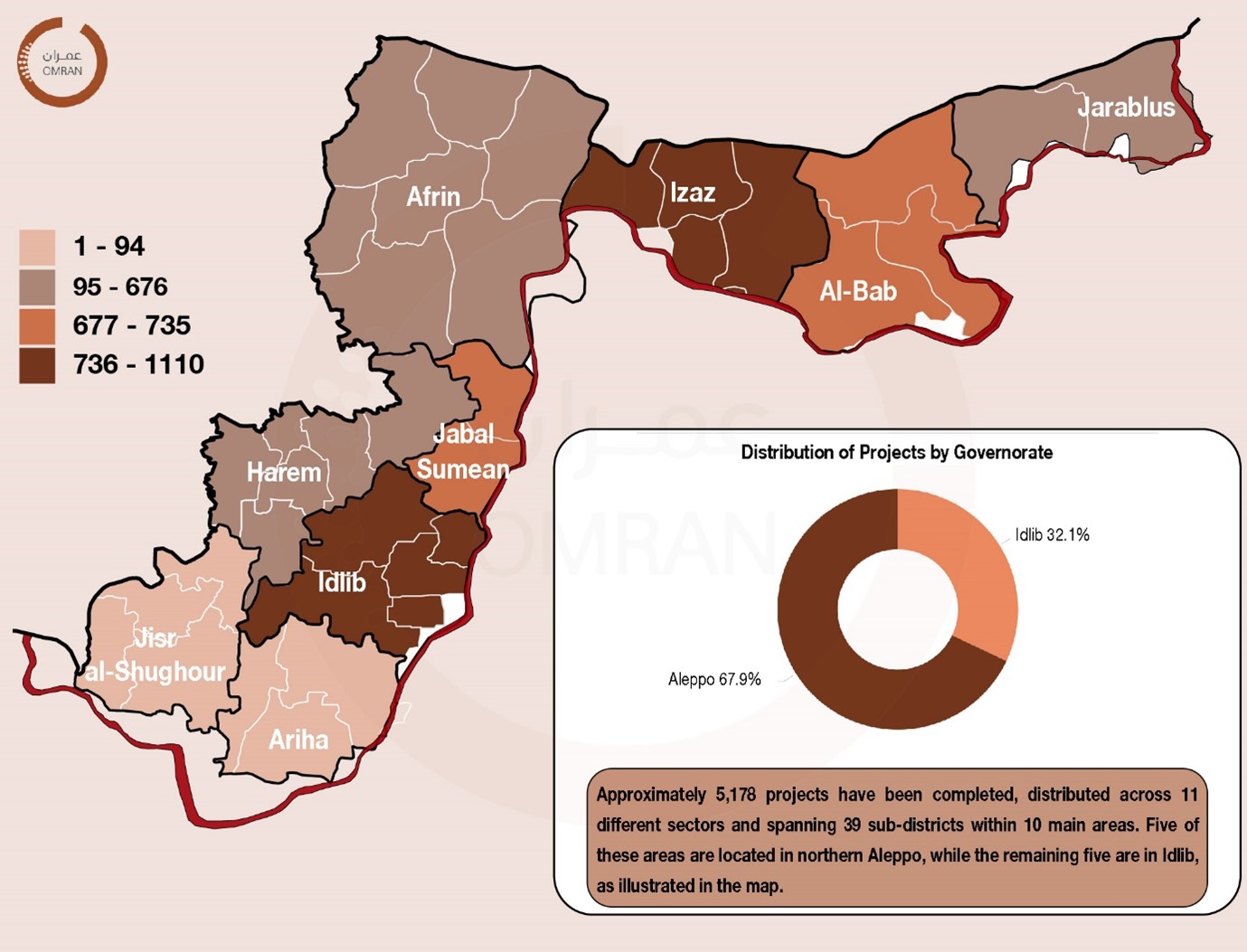
The finance sector was the most active, realizing 2,914 projects, followed by the social services sector with 413 projects and the electricity sector with 357 projects. The transportation and communications sector, along with water and sanitation, also saw significant activity, with 338 and 327 projects respectively. Meanwhile, the trade sector executed a total of 292 projects.

The data shows that rural Aleppo accounted for the largest portion of executed projects, with 68% (3,518 projects), compared to 32% (1,661 projects) in Idlib. This indicates a concentrated focus on developmental efforts in rural Aleppo over Idlib.

A deeper look into the distribution of projects across various regions and districts reveals that Atarib was the most active locality, followed by the cities of Jarablus, Idlib, A'zaz, and Al-Bab, as shown in Figure 4. The geographical concentration of projects in certain areas can be attributed to multiple factors: the presence of organizations in these districts, high population density, and large displaced populations, which increase the need for humanitarian and developmental projects. Additionally, favorable conditions for implementing projects in terms of security, available infrastructure, labor force, and proximity to logistical support centers further facilitated project implementation.
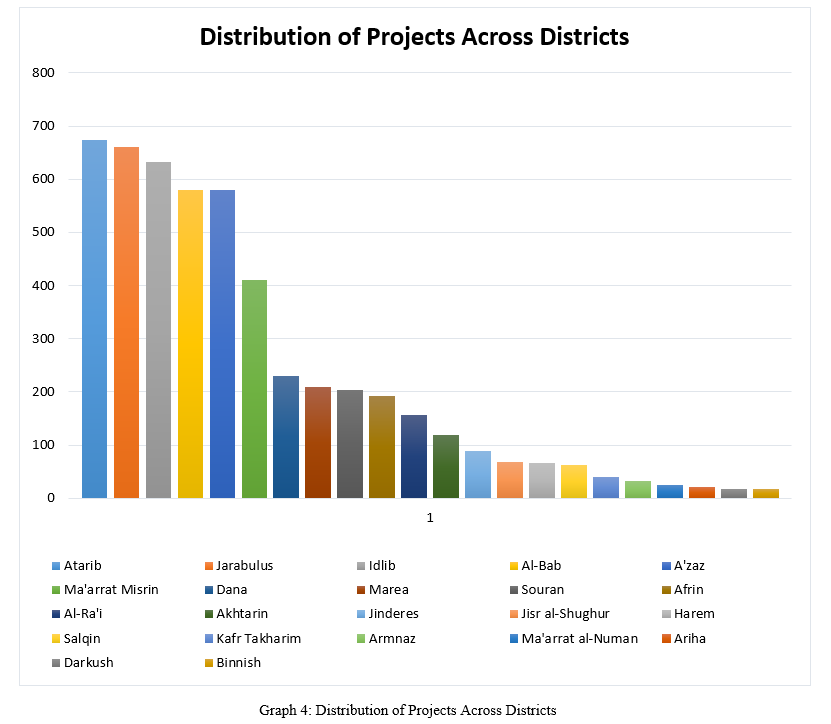
Among the significant events of 2023 that impacted the "early recovery" process was the devastating earthquake on February 6, 2023, which struck 137 cities and towns in rural Aleppo and Idlib, affecting over 1.8 million people, causing the deaths of 4,540 civilians, injuring about 12,000 individuals, and leaving 67 people missing. The disaster prompted the displacement of approximately 300,000 people, predominantly children and women. The earthquake also resulted in material losses, including the destruction of 433 schools and 73 health facilities, and the complete destruction of 1,867 buildings, with 8,731 homes and buildings partially damaged, according to figures from the "Support Coordination Unit".
In response to the earthquake, prominent organizations announced the formation of a "Joint Operations Alliance" consisting of "The Syrian Forum," "The Syrian American Medical Society," and "The Syrian Civil Defense" to coordinate efforts in addressing the disaster. Additionally, the Qatar Development Fund pledged support for the construction of a comprehensive city to shelter 70,000 people in northern Syria.
Economically, the transit fees for traders entering Turkish territories increased from $2,200 to $5,000 annually, which may impose financial burdens on traders and industrialists, potentially Shrinkage industrial and commercial businesses. A commercial court was established in Sarmada, Idlib, aimed at resolving commercial disputes among traders registered with the chambers of trade, covering intellectual property, bankruptcy, disputes related to commercial papers, currency exchange, commercial remittances, and banking activities.
Local councils in rural Aleppo seek alternatives for providing power at reasonable prices amidst the increasing suffering of residents and entities from rising electricity prices. They threatened electric companies to terminate contracts and applied increasing pressure, resulting in reduced subscription fees to 2.77 Turkish lira for homes and 3.17 TL for commercial in Jarablus, Afrin, and A'zaz, down from 4.24 TL for homes and 5.75 TL for commercial.
The Ministry of Finance in the Interim Government launched the first investment conference, aiming to develop the region, contribute to improving living standards, and increase employment opportunities. The Interim Government and the "Syrian Salvation Government" set the price of durum wheat at $330 per ton and soft wheat at $285 per ton, which is $100 less than the pricing in the "PYD" area, while the price in areas controlled by the regime is $222. Lastly, fluctuations in the Turkish lira negatively affected economic life and significantly slowed down commercial activity in Idlib and rural Aleppo.
A Look at the Sectors of Early Economic Recovery
In 2023, organizations implemented 2,914 projects within the finance sector, focusing particularly on areas such as A'zaz, Jebel Saman, Jarablus, Idlib, and Al-Bab, which saw the highest number of projects. The significant emphasis on the finance sector is due to the continuous operations of the “Hayat Fund,” “Syria Recovery Trust Fund,” and other organizations involved in direct cash interventions.
The growing interest in the finance sector plays a pivotal role in stimulating the economic recovery of the area by providing the necessary liquidity and supporting small and medium-sized enterprises, which in turn contributes to job creation and increases productivity. It also enhances social stability by enabling residents to improve their financial income, reduce poverty, diversify income sources, and reduce dependency on humanitarian aid and economic activities, increasing their resilience to economic shocks. Moreover, it develops the financial infrastructure of the area through the establishment of financial institutions capable of offering diverse financial services, encourages innovation, and entrepreneurship to develop emerging projects.
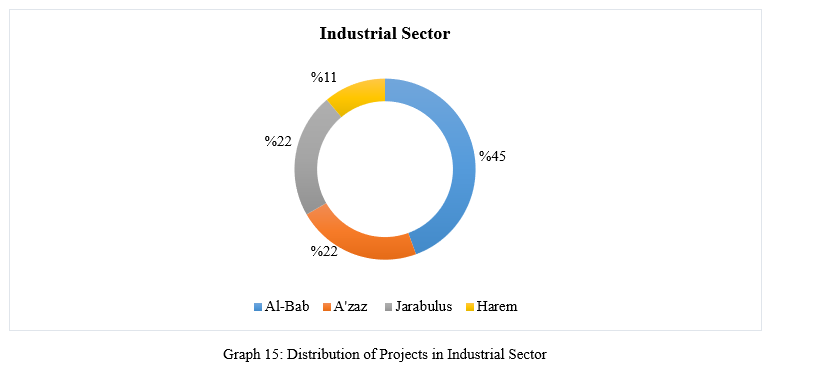
In the social services sector, 413 projects were implemented during 2023, marking an increase compared to previous years. This increase is primarily attributed to the urgent need to rehabilitate the health and education infrastructure severely damaged by the devastating earthquake on February 6. Organizations concentrated most of their budgets on repairing schools, hospitals, and public facilities such as bakeries, markets, and shops, which were either completely or partially damaged. New schools and hospitals were established, including Amanos University in Afrin, which encompasses several departments such as the College of Health Sciences, Nursing, Anesthesiology, Laboratory Analysis, and Radiography. This step underscores the critical importance of education in the processes of recovery and social rebuilding. Additionally, the removal of debris and damaged buildings continued, as civil defense teams executed a three-phase earthquake response plan. The first phase involved emergency response to search for survivors and retrieve the bodies of victims, clearing roads, securing risks from collapsing walls, and finally, debris removal.

357 projects were implemented within the electricity sector, particularly in Idlib, A'zaz, and Afrin. These projects included the rehabilitation of the electrical infrastructure through the maintenance of electric poles and transformers, the preparation and maintenance of medium and low voltage power lines, the installation of meters, and the extension of cables. The projects also included street and residential area lighting. Moreover, the reliance on renewable energy continued as organizations installed solar power systems for schools and hospitals, reflecting the pursuit of sustainability and the reduction of dependence on traditional energy sources.
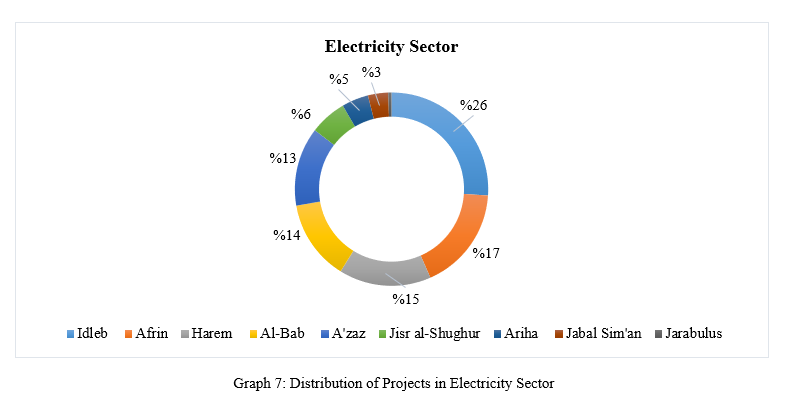
The transportation sector saw 338 projects, with Idlib, A'zaz, Harem, Al-Bab, and Afrin being the areas with the most projects completed. The continuous focus on these projects aimed at improving the infrastructure of roads in vital areas, reflecting the importance of the road network between cities and towns. This focus plays a pivotal role in facilitating the movement of goods and individuals, enhancing the connections between communities and markets, improving access to essential services, and bolstering the ability to reach educational and healthcare services. Among the main roads paved are: the international road connecting Idlib with Bab al-Hawa, the eastern corniche road in Ma'arrat Misrin spanning 800 meters, the road between Darkush and Ain al-Zarqa, the road between Kafr Karmin and Atarib, the road between Sarmada and Harem stretching 9,500 meters, and the third Afrin bridge, which is 1,650 meters long.
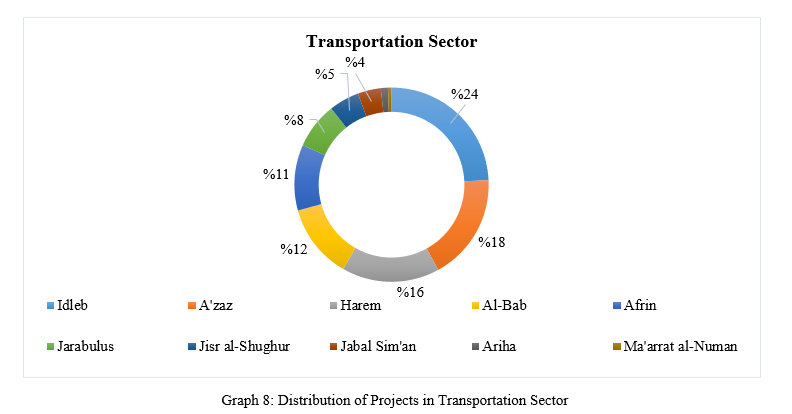
Within the water and sanitation sector, 327 projects were implemented. One of the most prominent projects in this sector was the inauguration by the Syrian Interim Government of a solar energy system for drinking water pumping stations in Al-Bab. This project, costing an estimated 2 million euros, has a production capacity of 1.15 megawatts, making it the largest service project of its kind. It utilized 2,547 solar panels to serve approximately 200,000 residents in Al-Bab, supported by the “Syria Recovery Trust Fund.” The use of solar energy to operate water pumping stations represents a major effort towards transitioning to renewable energy sources and environmental sustainability.
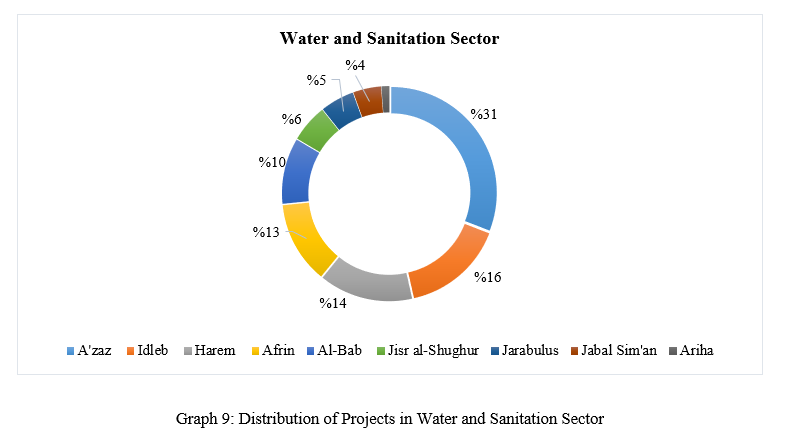
The trade sector saw approximately 292 projects implemented, with the majority concentrated in Idlib, reflecting its significance as a major commercial hub in the area. The projects executed in this sector encompassed a range of economic and service activities, including the tender contracts issued by organizations to supply various goods and execute various services. These included the supply of water, diesel fuel, electrical and medical equipment, book printing, stationery, and communication equipment, as well as car rental and other essential services. The reliance on tenders as a mechanism for implementing these projects enhances the standards of transparency and efficiency in selecting the best offers, thereby maximizing the possible value from available resources. It also facilitates cooperation between international and local organizations and the private sector, thereby strengthening the role of partnerships in the economic recovery process.
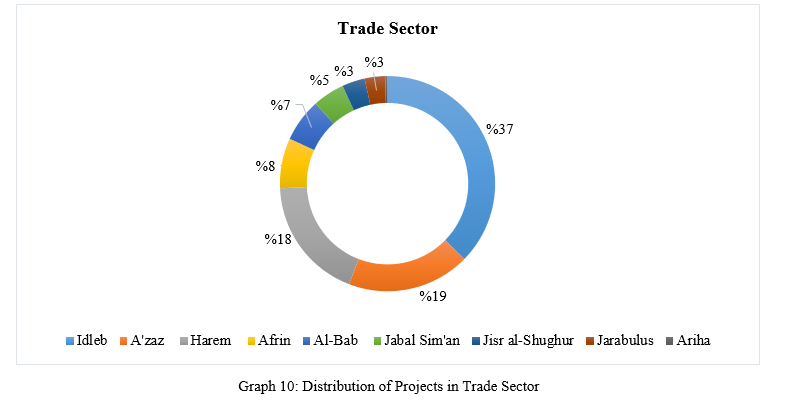
In the internal displacement sector, 256 projects were implemented, with a focus on Idlib, Harem, Afrin, A'zaz, and Al-Bab. These areas host the largest displaced populations and have become focal points for implementing projects aimed at improving infrastructure and living conditions for the displaced. The projects executed covered various aspects of essential services within the camps, including paving roads with gravel to facilitate movement and access, extending sewage networks to ensure sanitation and public health, and renovating homes to provide safer and more comfortable shelters.
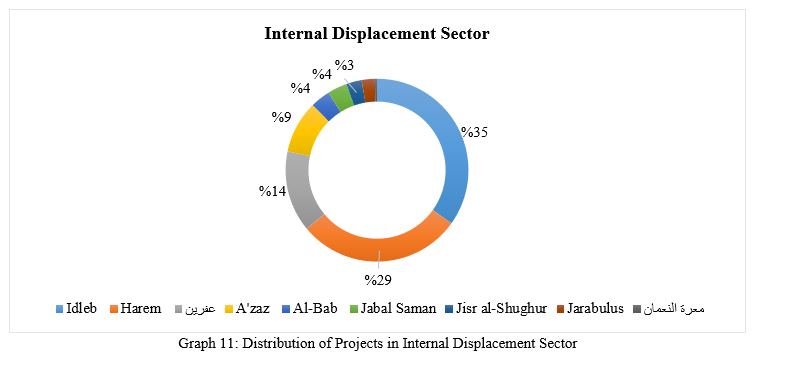
In 2023, 142 projects were carried out in the housing and construction sector, with the city of Al-Bab leading with 74 projects, as seen in previous reports, due to the common licensing granted for the construction of residential and commercial buildings. Organizations established several residential complexes aimed at improving living conditions for people residing in camps by relocating them to new buildings equipped with all essential services. These include the Al-Salam Complex, the third Al-Bonyan Residential Complex, and the villages of Rahma, Balsam, Al-Nasr, Qa'rqalbin, and Rawafid Al-Khair. The continuation of these projects is intended to alleviate the pressure on overcrowded camps and provide a relatively better living environment for the IDPs.

In the agriculture and livestock sector, 102 projects were implemented with notable support from the “Syrian Recovery Trust Fund.” This included the launch of an agricultural project aimed at supporting farmers in the cultivation of irrigated wheat over an area of 2,000 hectares, spread across towns and cities such as Al-Ghandoura, Al-Ra'i, Bza'a, Marea, and A'zaz. The Humanitarian Relief Authority provided support to 950 wheat farmers in Northern Rural Aleppo by supplying necessary agricultural inputs such as wheat seeds, superphosphate fertilizer, urea fertilizer, and diesel for irrigation, along with cash vouchers covering the costs of farming, irrigation, and harvesting. These efforts reflect a commitment to enhancing food security and supporting the local economy through the development of the agricultural sector, which is a fundamental pillar for the economic recovery of the region. It also contributes to creating job opportunities for farmers and enhancing their resilience against economic challenges. The importance of agricultural projects as drivers of economic growth and stability in rural communities is highlighted through the provision of resources and technical support to farmers, enabling them to improve their productivity and the quality of their crops, leading to self-sufficiency and reduced dependency on food imports.

In the telecommunications sector, 28 projects were implemented, including improving and expanding the telecommunications and internet infrastructure. Key projects featured the maintenance of main and subsidiary cables in the town of Binnish, with capacities of 450 lines for the main cable and 550 for the subsidiary, and the expansion of a subsidiary network for landline and internet services on Thalatheen Street in the city of Idlib. Additionally, the university communications center underwent expansions to the landline and internet networks to cover new areas such as Douar Al-Fallahin, along with extending internet cables throughout the city streets. The "Syrian Salvation Government" also launched mobile telecommunication services under the name SYRIA PHONE. This project represents a step towards enhancing communication services in Idlib. Providing strong and reliable communication networks is essential for achieving economic and social development, as it opens new prospects for education, business, and online services.

Finally, in the industrial sector, nine industrial projects were implemented in the area. Among these projects were the establishment of a factory for producing powdered infant milk in the industrial area of Al-Ra'i, a diaper production facility in Jarablus, and the first iron and profile production factory. Additionally, a cement factory in Al-Ra'i and an Indomie factory in the industrial city of Bab al-Hawa were established. Efforts were also made to complete the industrial city in A'zaz and to open the industrial city in Marea. Despite the industrial sector being a key pillar in recovery and a vital part of the economic stability strategy, which reduces dependence on imports and enhances competitiveness, the region still faces significant challenges that hinder the development of the industrial sector.

Results and Recommendations
The report addresses the efforts of early economic recovery in northwest Syria during 2023, focusing on the activities of local councils and organizations across 11 sectors. It covers improvements in sectors such as finance, agriculture, trade, and services, in addition to ongoing challenges in infrastructure and economic stability. From the data presented in the report, several conclusions related to recovery efforts in the region can be drawn, including:
- Overcoming the Earthquake's Effects: Despite the extensive destruction caused by the earthquake, the area managed to implement approximately 5,178 projects, underscoring the local community's resilience and recovery from the disaster's shock. The continuation of projects by local councils and NGOs contributes to the gradual transition from relief and humanitarian aid to early recovery. In this context, it is crucial to expand advocacy efforts to attract the attention of the international community and donors towards recovery, highlighting the importance of projects in all sectors and achieving economic and social stability in the area.
- Enhancing the Role of the Finance Sector: The finance sector played a significant role in supporting the early economic recovery process in 2023, providing job opportunities and diversifying household income sources. Financing small and medium-sized projects and providing direct financial support to families will contribute to economic independence and job creation. To ensure sustainability and optimal impact, it is essential to develop effective monitoring and evaluation systems and establish training programs to enable beneficiaries to manage their projects successfully.
- Improving Infrastructure: Projects implemented in the transportation, communications, water, and sanitation sectors played a pivotal role in supporting the area's economic recovery, particularly in road repairs and improving water supplies. However, challenges arising from population density and ongoing shelling targeting infrastructure, alongside drought issues, necessitate a more significant international effort in these sectors.
- Supporting Agriculture and Livestock: The agriculture sector faces complex challenges due to drought, rising raw material prices, labor migration, and reduced profitability of agricultural activities due to obstacles in exporting and marketing products. To address these challenges, it is crucial to support this sector by providing subsidized seeds, feed, equipment, and pesticides to reduce production costs, enhance crop marketing, integrate crops into food industries, and develop initiatives to promote them in foreign markets.
- Stimulating Industrial Growth: Providing a stable environment will attract significant investments and facilitate the operations of existing factories and workshops in the area, encouraging industrialists to relocate their operations from areas adjacent to Turkey to rural Aleppo and Idlib. This can only be achieved through reducing electricity prices, offering material and financial incentives to manufacturers, developing effective marketing and export strategies, and accessing the international financial system more extensively.
- Encouraging Small and Medium Enterprises: Given the current economic situation, it is essential to focus on developing workshops and small and medium-sized projects in the region, particularly in technical and computing fields, which are characterized by their flexibility, adaptability, and potential for marketing beyond borders.
- Addressing the Shortage of Humanitarian Aid Funds: Given the shortage of humanitarian aid funds from the international community, the region faces an urgent challenge that calls for adopting diverse and innovative financing strategies to achieve a degree of economic independence. Therefore, governance bodies and organizations should enhance investment tools, build a private sector and financial institutions, and conduct advocacy campaigns in expatriate countries to gather the necessary funding to implement economic plans.
In conclusion, the Interim Government, Local Councils and non-governmental local organizations managed the recovery phase with reasonable effectiveness in terms of resources, governance, and organization, despite the severe crises experienced in the region, especially the earthquake disaster on February 6, 2023. The implemented projects played a pivotal role in driving early economic recovery and ongoing development since the relative stabilization of the region after the years 2016 and 2018. However, there is an urgent need to develop an effective mechanism for an overall economic plan for the entire region (synchronized with other regions) that ensures the adoption of a specific economic model based on well-considered decisions and policies. This plan should address profound challenges such as the crisis of missing legal documents, water, electricity, industry, the financial environment including currency, pricing, and financial institutions, improving conditions for the displaced, and establishing a comprehensive legal framework to deal with vital issues and casesTop of Form.
Early Recovery Trust Fund in Syria: A Technical Approach With Political Implications and Associated Risks
The topic of early recovery is currently a focal point among UN circles and donor entities, as well as among Syrian parties, individuals, institutions, and organizations. In this context, the United Nations, through the Office of the Humanitarian Coordinator in Damascus, announced its approach to establishing an Early Recovery Fund. This announcement has been accompanied by leaks and rumors regarding the fund, its operational mechanisms, and its funding size. Additionally, the announcement has sparked reactions and discussions among donors and Syrians alike. This situation necessitates an initial analysis of this proposal, examining the opportunities it presents and the risks it entails, ultimately leading to recommendations that could guide the fund's operations and ensure the achievement of its intended goals.
Early Recovery: A Problematic Concept and a Syrian Perspective
The concept of early recovery in post-conflict areas is highly debated within humanitarian circles, NGOs, and among donors, primarily due to the absence of a standardized recovery framework for post-conflict scenarios. This gap contrasts sharply with the well-established frameworks for post-disaster recovery. The varying perspectives and distinct demands of stakeholders on early recovery in Syria contribute to its dynamic nature, and continuously shaped by both political and humanitarian considerations throughout the stages of conflict. This puts forward a unique opportunity for Syrians to develop an approach that reflects their specific realities in a more holistic methodology.
In 2008, the United Nations Early Recovery Cluster published its initial Guidance Note on Early Recovery, defining it as "a multidimensional recovery process initiated from a humanitarian context, guided by development principles aimed at leveraging humanitarian programs to foster sustainable development opportunities. The objective is to cultivate self-reliance mechanisms, uphold national ownership, and ensure resilience throughout the post-crisis recovery phase. This process includes the restoration of all essential services such as livelihoods, shelter, governance, security, rule of law, and environmental and social dimensions, with a particular focus on the reintegration of displaced populations(1)Also, TheGlobal Cluster for Early Recovery (GCER) offered an expanded definition, describing early recovery not merely as a phase but as “a thorough, multidimensional process that commences early in the humanitarian response. It focuses on bolstering resilience, restoring, or enhancing capacities, and addressing enduring issues that contributed to the crisis rather than exacerbating them, alongside a suite of programs designed to aid the transition from humanitarian relief to development.(2)While The U.S. Agency for International Development (USAID) characterized early recovery as “an approach that meets recovery needs emerging during the humanitarian phase of an emergency, where saving lives remains a critical and immediate priority. Early recovery initiatives support affected communities in safeguarding and reinstating essential systems and service delivery, building upon initial response efforts, and establishing a foundation for prolonged recovery. The outcomes of these early recovery efforts include creating robust foundations for resilience post-crisis, fostering sustainable development solutions led by national or local entities, and rebuilding community capacities(3).
From these definitions, it is evident that Early Recovery is a multidimensional approach that builds on humanitarian response, aiming to stabilize communities and enhance their adaptive capacities. However, there is debate about the content and scope of early recovery. De Vries and Specker argue that early recovery is a period between the humanitarian phase during and immediately after a conflict and the medium to long-term development phase. While some researchers and humanitarian agencies define the first three years after the end of a conflict as the timeframe for early recovery, according to the UNDP program, early recovery can begin even before the conflict parties reach a political settlement(4).
Early recovery in post-conflict situations is closely associated with the stakeholders involved in recovery and their interests. This makes the transition from conflict to peace not merely a technical approach and practice but a highly political process in which principles, priorities, and concepts vary. This variability is highly evident in the Syrian context and explains the diversity of approaches to this concept. Some argue that the early recovery process should begin once the conflict has ended, in response to attempts by the Syrian regime to initiate this process before achieving a political solution. It aims to establish peace and stabilize “state institutions” through a mix of different policies. There are at least four main threads that form the foundational concepts of “early recovery.(5)
- Humanitarian aid frameworks;
- Economic growth and development;
- Peacebuilding and human security;
- Governance models and state-building.
Conversely, The Operations and Policy Center (OPC) defines early recovery by comparing it to the concept of reconstruction as: “An activity that lies between the prevalent approach focused on basic humanitarian aid (food, shelter, water and sanitation services, hygiene) on one side and reconstruction on the other. Its priorities are arranged according to humanitarian needs, similar to other forms of humanitarian aid, which are planned and implemented by relief organizations, whether they are centralized under a single administrative authority like the United Nations or individual organizations.” Meanwhile, a study by The Day After (TDA) adopts the following definition for early recovery: “All the humanitarian and developmental efforts made by local and international entities to improve the economic and social conditions across the country, in addition to the efforts made in enhancing the effectiveness of institutions involved in improving these conditions. Thus, early recovery activities include supporting essential services such as health and education, projects supporting private sector work and employment opportunities, and initiatives promoting social cohesion.(6)
To clarify the concept, it is necessary to delineate the boundaries between early recovery and related concepts such as reconstruction and humanitarian response, which can be summarized in the table below.(7)
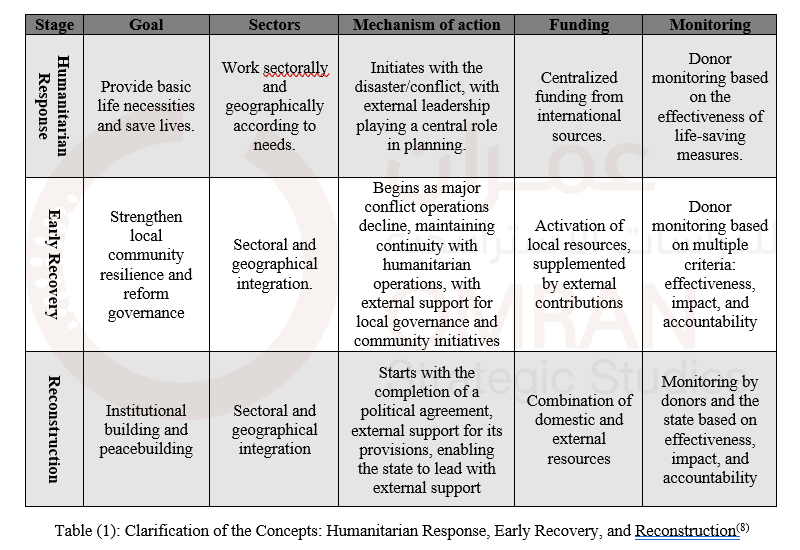
Based on the above, early recovery is considered a late stage of humanitarian intervention that commences as major military operations wind down. It increasingly depends on local communities and governance structures to manage the planning, funding, and implementation processes, with support from external actors. The primary objective of early recovery is to enhance the stability and adaptive capacity of local communities through projects that are integrated both sectorally and geographically. These projects are evaluated based on criteria of effectiveness, impact, accountability, and transparency(9)
The Early Recovery Trust Fund (ERTF): A UN Initiative with Political Content
Political negotiations among actors in the Syrian crisis, alongside the associated risks and repercussions of regional and international crises, have placed early recovery for Syria on the agendas of the United Nations and its donors. This has led to the development of a UN strategy to establish a trust fund for early recovery, although some aspects of this strategy are still being refined. Since 2013, early recovery and livelihoods have been recognized as a distinct cluster within the Syrian Humanitarian Assistance Response Plan (SHARP). From that year until 2023, the total funds requested for these projects amounted to approximately $1.691 billion, of which $420.5 million, or 24.8% of the total required, has been funded.
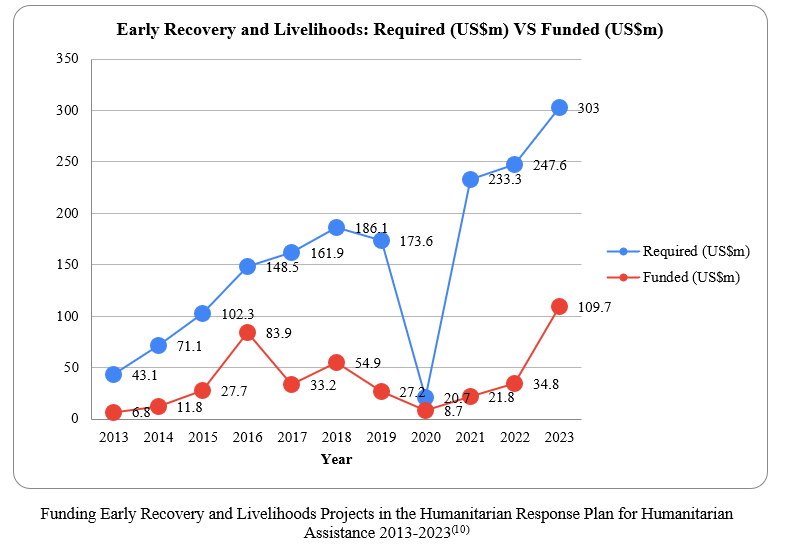
Funding for early recovery and livelihood projects between 2013-2023 has been limited by Western countries and the United States. They have adhered to the three "Nos": NO normalization with the Syrian regime, NO lifting of sanctions, and NO engagement in reconstruction without a political transition according to UN resolutions. This stance likely stems from their desire to continue pressuring the regime to advance the political negotiation process toward a resolution. This is in conjunction with existing humanitarian response mechanisms, exemplified by the cross-border aid mechanism established in 2014 under UN Security Council Resolution 2156.
Since 2020, discussions on early recovery have shifted due to a decrease in major military operations, the impact of political negotiations among actors in the Syrian crisis through various pathways and initiatives, and objective considerations related to the growing humanitarian needs amidst declining funding for the Syrian crisis. Moscow exerted pressure to modify the cross-border aid mechanism, initially reducing it to two crossings (Bab al-Hawa and Bab al-Salam/Resolution 2504), and later to just one (Bab al-Hawa/Resolution 2533), with a focus on early recovery projects as defined by Security Council Resolutions 2585/July 2021, 2642/July 2022, and 2672/January 2023. These resolutions identified early recovery sectors including water and sanitation, healthcare, education, shelter, and electricity, providing early recovery efforts with a legal framework and UN legitimacy. Since 2021, attempts at normalization with the Syrian regime have gained momentum, characterized by the "step-by-step" approach, which was conceptualized by some think tanks and supported by Jordan and UN Special Envoy Geir Pedersen, where early recovery was one of its focal points(11)
The following determinants and objectives laid the groundwork for the UN proposal of the Early Recovery Trust Fund:
- Exploring solutions to a deadlock in the political process, especially as the Constitutional Committee meetings stalled since 2022, and the UN's interest in testing an economic-humanitarian approach to achieve a political breakthrough and advance the stalled negotiation process;
- Managing challenges of the Syrian crisis, particularly with the suspension of the cross-border aid mechanism since July 2023, and declining funding for humanitarian response at a time when humanitarian needs are expected to rise (UN estimates that 16.7 million people in Syria will need assistance in 2024), possibly linked to changing donor priorities under the pressure of regional and international crises;
The relaxed stance of the US administration towards Arab efforts to normalize and communicate with the Syrian regime, and the exceptions granted from sanctions (June 2021, May 2022, February 2023), and earlier flexibility with Russian demands to include early recovery in Security Council resolutions, which provided leeway for Arab initiatives towards Damascus, indicating the possibility of funding early recovery projects if Damascus complies with specific steps.(12)
Humanitarian diplomacy to overcome sanctions and activate the Arab role: This was evident in the aftermath of the February 2023 earthquake and the diplomacy of disasters through the role of the UAE as a mediator, achieving a bilateral agreement between the UN and the Syrian regime to introduce UN aid through border crossings with Turkey outside the UN mandate(13)as well as the UAE's use of the earthquake disaster to circumvent sanctions imposed on the regime and send aid to it, thereby laying the groundwork for proposing a secure and legitimate mechanism under a UN umbrella for Arab donors to support early recovery projects, away from the constraints of US and European sanctions, as indicated by the UN Coordinator for Humanitarian Affairs in Syria, Adam Abdelmoula(14)
- Conversations led by Martin Griffiths, Deputy Secretary-General for Humanitarian Affairs and Emergency Relief Coordinator, with the Syrian regime post the February 2023 earthquake framed the UN proposal for the Early Recovery Trust Fund initiative, culminating in a decision by the UN Secretary-General in June 2023, directing the UN team in Syria to prepare a five-year early recovery program, including a clear plan for securing its funding. The war on Gaza and concerns about its implications for regional stability, specifically Syria, the regime's stance towards it, and what can be relied upon from the Early Recovery Trust Fund to influence the relationship between the regime and its allies, particularly Iran, were factors that paved the way for the UN proposal, overcoming any US or Western opposition.
The draft conceptual note for the UN’s ERTF defined it as an additional mechanism alongside existing ones (Syria Humanitarian Fund (SHF), Syria Cross-border Humanitarian Fund (SCHF)). The objective of ERTG would be to secure funding outside the humanitarian response plan for early recovery projects over five years (until 2028) based on the following priorities that would help build the adaptive capacity of local communities: health and nutrition, education, water services and sanitation facilities, livelihoods, and electricity. The fund consists of a steering committee, a technical committee, and a secretariat initially based in Beirut, with the Resident Coordinator and the UN Coordinator for Humanitarian Affairs in Syria leading and coordinating the overall management of the fund in consultation with donor entities and participating organizations. As for funding the fund, governments, international governmental and non-governmental organizations, and private sector organizations were identified as contributors to this fund, with several sources indicating that the initial ceiling of the fund would be $500 million over five years, noting a lack of enthusiasm from the United States and Europeans to fund this initiative. However, many points remain subject to questioning, especially regarding the role of the United Nations Development Programme (UNDP) and the World Bank in managing this fund, the possibility of increasing the funding ceiling in the future, the stance of Gulf countries towards this fund, as well as the role of the Syrian regime in this fund, and the fair distribution of early recovery projects across influence zones.
ERTF: Identifying Risks and the Need for Guiding Principles and Standardized Frameworks
ERTF offers significant opportunities but also encompasses considerable risks, necessitating the implementation of guiding principles and standard frameworks for fund governance to ensure its effective contribution to achieving stability and advancing the political negotiation process. Concerns raised by numerous Syrian experts, organizations and political bodies, intersect with those by some donors regarding the fund's operation and its expected outcomes. These concerns stem from the UN’s previous experiences in Syria, marked by diminished transparency and manipulation by the Syrian regime to further its own interests.
The opportunities and risks of the fund can be summarized in the following table:

Strategies to Ensure Effective Implementation of ERTF
United Nations:
- Govern and manage the ERTF in a wise, neutral manner and seriously consider a neutral location for the fund, ensuring that projects cover all geographical areas of Syria without restrictions and guarantee the involvement and utilization of Syrian organizations’ capacities in the process, including monitoring, guiding, and implementing.
Syrian Organizations:
- Enhance the capacities of Syrian organizations to respond to early recovery projects, and incorporating this even in their humanitarian response.
- Ensure the voice of Syrian organizations in early recovery through: 1) Launching advocacy campaigns in major capitals at all levels to prevent the Syrian regime from monopolizing the process and redirecting it towards its interests, 2) Organizing workshops and events to discuss early recovery and formulate a common ground on the issue, 3) Developing an index to classify regions based on their needs and readiness for inclusion in early recovery projects, with continuous updates and sharing results with relevant entities, 4) Integrating the roles of Syrian organizations concerning early recovery, and their efforts to build alliances across influence zones to ensure a positive impact on this process.
Donors:
- Avoid granting the Syrian regime free gains without extracting substantial concessions that enhance stability and advance the political negotiation process.
- Bind the United Nations to the following guiding principles for early recovery projects: 1) Aimed at supporting the stability and adaptability of local communities, 2) Capable of connecting influence zones and activating national value chains, 3) Implementing early recovery projects in a decentralized manner that considers the local context of each region, 4) Ensuring that external actors facilitate and support the process, not lead it, enhancing local ownership and engagement.
- Emphasize to donors that while the Early Recovery Fund is an important mechanism to support stabilization efforts, it is insufficient on its own, and the continuity of other response mechanisms for the Syrian crisis must be maintained.
([1])UNDP Policy on Early Recovery, United Nations Development Programme, 22 August 2008. https://bit.ly/31aEU66
([2]) Global Cluster for Early Recovery (GCER), United Nations Development Programme, https://shorturl.at/ntMR1
([3]) Strategic Framework for Early Recovery, Risk Reduction, and Resilience (ER4), USAID'S BUREAU FOR HUMANITARIAN ASSISTANCE, October 2022, https://shorturl.at/jqtQ5
([4]) Dr. Salam Saeed, Early Economic Recovery in Syria: Challenges and Priorities, in the book Economic Recovery in Syria: Actors Map and Evaluation of Current Policies, Omran Center for Strategic Studies, 25.09.2019. https://shorturl.at/eCDJN
([5])Osama Al-Qadi, Correcting Perceptions. OSHA and "Early Recovery"!", Syria TV, 26.04.2021. https://shorturl.at/cfg79
([6]) Sami Akil, Karam El Shaar, Early recovery and reconstruction in Syria between reality and politics, 07.02.2022. https://shorturl.at/ABL57
([7]) Zaki Mahshi, Mohammed Al-Sattouf, The impact of early recovery and reconstruction projects on housing, land, and property rights in Syria. 30.01.2024. https://shorturl.at/lrzNS
([8]) A workshop hosted by the Omran Center for Strategic Studies, featuring Syrian experts, took place in Istanbul on April 16, 2023.
([9]) See Reference 8
([10]) Financial Tracking Service – OCHA. Syrian Arab Republic Humanitarian Response Plan. https://shorturl.at/rzPY7
([11]) Like, A Path to Conflict Transformation in Syria. A Framework for a Phased Approach. Carter center. Jan 2021. https://bit.ly/3ZDEe8o, and d Raphael Parens and Yaneer Bar Yam. Step by Step to Peace in Syria. New England Complex Systems Institute. 09 Feb 2016. https://bit.ly/3kjb4v1
([12]) Ibrahim Hamidi, Al-Majalla publishes the Jordanian Initiative for Syria... Three phases end with the exit of Iran and Hezbollah, Al-Majalla, June 25, 2023, https://shorturl.at/vEFV9
([13]) Laila Bassam, Ghaida Ghantous, Maya Gebeily and Tom Perry. Exclusive: Assad approved Syria quake aid with a UAE nudge, sources say. Reuters. 23.02.2023. https://shorturl.at/cmGT5
([14]) Muwaffaq Mohammed, extends for 5 years and includes projects including electricity, and is financed through a special fund. And enthusiasm for the contribution of Gulf countries ... Abdel Mawla to Al-Watan: Before the summer, we will launch an early recovery program, Al-Watan, 31.03.2024. https://shorturl.at/djFPZ
([15]) See Reference 8
panel in Brussels Conference entitled: "Harnessing Economic Autonomy for Peace: Reimagining Syria’s Path Forward"
Omran Center for Strategic Studies with Support from SPI organized a side event at the 8th Brussels Conference on Supporting the Syrian people. The panel was entitled: "Harnessing Economic Autonomy for Peace: Reimagining Syria’s Path Forward." Our insightful panelists provided deep dives into economic strategies for peace in Syria.
Dr. Rim Tourkmani outlined Syria's current economic landscape, emphasizing the importance of strengthening local economies to contribute to peace efforts.
Mr. Samir Aita discussed granting regions economic autonomy, focusing on empowering SMEs and strengthening the middle class to impact the peace process positively.
Dr. Sinan Hatahet explored specific economic initiatives that support SMEs and the middle class, highlighting their significance in fostering political negotiations and sustainable peace.
The audience, comprising EU experts and governments' representatives,, development experts, and Syrian civil society leaders, engaged actively and offered diverse perspectives and solutions.
Thank you to everyone who joined and contributed to the enriching dialogue! Your participation is instrumental in driving our efforts forward.
#BrusselsConference
Post-War Generation Needs.. Educational Gaps in Northwest Syria as a Model
Executive Summary
- Education, along with its continuity, serves as a cornerstone of "early recovery". It plays a decisive role in maintaining the intellectual and cognitive development of the post-war generation. The significance of education is underscored by its unique role in fostering a high level of psychological, social, and economic stability for both the individual and the wider community.
- Understanding the obstacles and gaps that impede the progress of the educational process in northwestern Syria is essential. It is crucial to determine the depth, causes, and factors contributing to these challenges. Gaining this understanding will provide a concrete foundation for future policies. For effective resolution, we must grasp both the visible and hidden dynamics of the educational process.
- This understanding becomes increasingly vital, especially in the face of declining educationquality and the deterioration of its quantitative and qualitative adequacy. This decline is evidenced by increasing dropout rates, school truancy , and student failures. For instance, 18% of school-age children are not enrolled in any form of education, and more than three-quarters of students between the ages of 12 and 17 have left school.
- The diversity of players in the education sector and their differing policies resulted in a lack of clear governance. Instead of a single central authority, numerous centers of differing competencies, executive plans, roles, and authorities emerged. This scenario has led to the existence of a variety of educational certificates, in addition to the absence of a structured decision-making mechanism within the education system; and lack of clarity in roles and responsibilities which amplifies ambiguity within the educational process. This lack of transparency has consequently eroded the trust of students, parents, teachers, and administrators.
- The funding provided to support higher levels of education is on the decline, while the aid given to elementary educational stages remains insufficient (The Humanitarian Response Plan for Syria has only received 25% of its required funding). Furthermore, the lack of a single coordinating body to regulate the work among different organizations led to a duplication of efforts, resulting in additional wasted resources and efforts. Often, there's a noticeable absence of coordination among these entities.
- The nature of the relationship between the financial backers and the organizations often resulted in a lack of attention to the involvement of local entities in evaluation and implementation processes. A noteworthy observation in this context is the extensive distribution of protection and psychological support programs. Those far outnumber the programs and activities specifically aimed at supporting education.
- Both areas are suffering from a shortage of qualified educators and a lack of scientific expertise among teachers. Moreover, there is a noticeable decline in the overall number of teachers living in the camps. This shortage is primarily attributed to the permanent relocation of teachers due to displacement; or their extended absence from the majority of school hours as a result of living conditions. Adding to the complexity, the prevailing security chaos instills fear among teachers towards military entities and influential figures. Additionally, there is a distinct shortage of female teachers in the studied area, further exacerbating the issue.
- The area of study is suffering from low academic performance among students, particularly in fundamental subjects. This situation necessitates the implementation of enrichment programs within the curriculum to bolster student understanding, broaden their perspectives, and facilitate their integration with the modern world. This can be achieved through the incorporation of technology in the education process.
- Furthermore, an emphasis on promoting shared living values in the curriculum is crucial. Despite peace among individuals being largely contingent on political and societal agreements, the lack of curriculum content, or activities addressing communal living and societal interaction could potentially undermine the principles of citizenship. This could be especially detrimental during periods of societal conflict and in their aftermath.
- Indicators associated with infrastructure gaps in schools include factors such as the lack of presence and insufficiency of educational facilities, their geographic distribution, capacity, safety within the school environment, availability of playgrounds and physical activity areas, as well as the availability of necessary healthcare services. When it comes to teachers, indicators include their numerical adequacy, gender balance, financial compensation, educational qualifications, expertise, and the level of security they experience. Curriculum and educational resource-related indicators cover aspects such as curriculum modifications and structural aspects; indicators of educational poverty; investment in education; religious influences on the curriculum; as well as the availability of textbooks and supplementary educational resources. Student-related indicators include the importance of access to education, school dropout rates, financial capabilities of students, privatization of education, the impact of war, psychological pressures, and social factors affecting students.
- The study proposes several recommendations the educational gaps. These include the importance of launching advocacy campaigns to accurately assess needs and advocating for humanitarian aid to be allowed through crossborder mechanisms rather than being restricted to crossline deliveries. It also emphasizes the need to strengthen local involvement in overseeing the educational process and enhance coordination between different stakeholders. The study suggests going beyond relying solely on organizational estimates by establishing an official mechanism for needs assessment. Additionally, it recommends bolstering Syrian funding channels for education and working towards a self-sustaining Syrian financing cycle. Lastly, it highlights the necessity of supporting the creation of a dedicated mechanism to assess school needs, ensure proper technical specifications, and promote equitable distribution.
To Read Full Study: https://2u.pw/ntiRzdT
Soft Tools of the Assad Regime: “The National Union of Syrian Students as a Model”
Executive Summary
- The announcement of the establishment of the National Union of Syrian Students took place in April 1963. However, the Union remained without an official status and was not legally recognized until 1966 when Decree No. 130 was issued. The decision to establish the Union was made by the Regional Leadership of the Ba'ath Party, designating it as the sole "legitimate representative" of the student sector both within and outside Syria. Yet, Decree 23 of 1970 limited the Union's activities to university students, while the "Union of Revolutionary Youth" catered to students below the university level. Since then, the connection of the Union (legally, functionally, and structurally) with the central leadership of the Ba'ath Party became quite evident. Despite this, the party law issued in 2011 allowed the establishment of political parties and party activities in Syria. This was later followed by a constitutional amendment in 2012 that abolished the provision stating that the Ba'ath Party is the leader of the state and society, However, the union has remained inextricably linked to the Baath Party.
- Three laws were issued to regulate universities in Syria. The first was in 1958, which completely ignored any student representation within the university educational process. The second was in 1975, which introduced the concept of the National Union of Syrian Students as one of the entities overseeing the university educational process. The latest was the 2006 law, which limited student representation to those appointed by the Union in faculty councils and university scientific affairs councils. This law underwent several amendments adding new categories to scholarship recipients, accommodating individuals who joined the army after 2011.
- Student organizations at all levels, starting from the "Ba'ath Vanguards", passing through the "Union of Revolutionary Youth", and ending with the National Union of Syrian Students, serve as training centers for Ba'athist cadres. Upon graduation, these cadres either move on to lead unions or assume other positions in the state. Through these sequential institutions, students are conditioned on one hand, and their loyalty to the ruling authority is ascertained on the other. Consequently, the idea of elections within the Union is more about affirming the loyalty chain rather than being a democratic process where students choose their representatives, who are then tasked with advocating for student rights in educational and ministerial councils.
- The universities vary in the composition of their union branches, which can be divided into three types: branches where the sectarian dimension is evident within the union's structure, such as the Tishreen and Baath branches; branches where the composition is related to cities and the distribution of power, such as Aleppo and Damascus; and branches where the union leadership does not have significant influence within the overall union, and the members are often from the same city, such as the Deir ez-Zor and Daraa branches. This diversity has impacted the roles of the union and its interactions in the post-2011 era.
- Among the roles and tasks of the union, one notes its functional role, as manifested through its interaction with the regime's foreign policies and its support for internal decisions at both the university and state levels. There is also its military role, evident through its activities with the Baath Brigades in 2012, arming supportive students and overseeing their inspection of other students. In addition, there is its political role, either in promoting the regime's narrative or in developing strategies to counteract sanctions imposed upon it. Despite these sanctions, the union has remained an active participant in international conferences, representing the Assad regime. Finally, the union has a social role, which involves supporting the regime socially beyond the university setting, as exemplified by the establishment of institutions focused on relief efforts, such as the "Wounded Homeland" project.
Introduction
Understanding the social and political structures that the Assad regime controls is a fundamental step towards understanding the dynamics of its governance and its executive vision for political and social life. The levels of analysis range from an internal examination of social structures to analyzing their relationship with the ruling regime, and to what extent each influences the other in decision-making processes or changing societal ideas, all the way to altering its composition and beliefs. From this perspective, we study the dynamics and philosophy of the “National Union of Syrian Students” as the sole organizational framework for students on one hand, and as a host for the potential carriers of developmental and progressive ideas on the other hand, while attempting to understand how it monopolizes student work and uses it to serve the regime's narrative.
Research issues related to the Union have occupied varying spaces in the field of studies. Some have tried to quickly touch on some of these issues such as the relationship between the Union and the Ba'ath Party, as done by Adnan Amin in his research on governance of education in the Arab world. He pointed out the Ba'ath's control over the entire educational process, whether at the level of the Teachers' Union, which was transformed from an independent entity into a popular organization, including all civil service employees in the ministries of education, or at the level of forcibly affiliating students to the Union, while prohibiting any political activity in universities outside the Union framework. Amin, however, did not touch on the legal frameworks, legislations, and decrees that led to Ba'ath's control over trade union work, especially student work.([1])
Meanwhile, other studies focused directly on presenting a model of co-opting student work through its militarization by forming “Ba'ath Brigades” from students in Syrian universities to be ancillary forces for the regime's army, or even to monitor and chase activists outside the university framework, or through unofficially arming supporting students to control universities and their affiliated dormitories to prevent any revolutionary activity within them. This was clarified by Ali Jasim in his research paper “Under the State: The Rise of Ba'ath Brigades at Aleppo University after 2011” ([2]), and it was also demonstrated by testimonies of some students in favor of a research paper issued by the International Foundation for Education at the University of California, titled “Syrian University Students and Professors in Turkey”. These testimonies focused on cases of arming students and their role in arresting and torturing their peers.
Moreover, Rahaf Dagali's study in her paper issued by the British Journal of Middle Eastern Studies, titled “Departure of Secularism: Seizing the Borders and Expanding the Syrian State in the Religious Field Since 2011”, shed light on an important aspect in the dynamics of linking civil institutions in Ba'ath policies. It looked at the model of the twinning of one of the organizations affiliated with the Ba'ath and the Ministry of Religious Endowments, through the launch of the Religious Youth Team associated with the Ministry of Religious Endowments and its cadres from the National Union of Syrian Students, to establish religious awareness projects and dialogue sessions.([3])
In light of that, this study identifies its qualitative scope by focusing entirely on understanding the complete picture of the Union and its roles and activities, and clarifying the impact of the legal engineering that regulates its work on enhancing the regime's tools in absolute control of civil institutions on one hand and mobilizing emerging generations and using them as a soft tool to serve the regime's policies and maintain its narratives on the other. The study will rely on the historical method to understand the Union's historical dynamics, and to show the reciprocal relationship between these dynamics and the regulating laws. It will also rely on the analytical method and its tools in monitoring its activities and purposes that transcend organizational rules, especially after 2011, let alone drawing the structural frameworks that regulate the work of this civil organization.
Therefore, drawing the legal frameworks and organizational structure would be a unique entry point in understanding the dynamics of the regime in monopolizing the civil space and exploiting it in “protecting” its general narrative, whether through reading the regime's ability to adapt these frameworks with the developments of the public scene, or through tracking the change in the Union's roles within the needs of the regime and its challenges. That will also somewhat contribute to shaping valid recommendations for this exploitation and investing it for the benefit of creating independent student spaces.
Historical Brief: Regulation and Control of Union and Civil Work
In the early 20th century, union work in Syria emerged as an upgrade of the professional and craft associations compared to the 19th century. This was driven by the necessity to protect occupations from unjust practices and prejudiced laws issued by authorities, and the need for internal leadership, such as the concept of “Sheikh al-Kaar”([4]) to regulate work and arbitrate disputes among members of the same profession. Union work began to shine through the Ottoman state's decision in 1909, which its influence continued during the French “mandate” era later until 1935, due to the absence of legislation related to civil work in this era, ([5]) which was naturally reflected in the establishment of several unions during this period, such as the Bar Association, ([6]) and the labor movement.([7])
In the post-independence era, despite the continued absence of updated legal frameworks, union and student gatherings developed tools for local confrontation. While they adopted the narrative of demanding independence and rejecting division during the mandate era, they began demanding the preservation of rights and resisting attempts to suppress freedoms by the military and some political powers during the independence era. This was evident in the first direct clash between the student movement and the military led by Sami Hanawi. This dynamic was a contributing factor in the adoption of the 1950 constitution, which expanded the scope of civil and union work in Syria. This is reflected in Article 17, which gave citizens the right to form associations and practice union work.([8])
During the unity phase between Syria and Egypt, the authorities attempted to control the funding sources of organizations and unions, frame their work, and reduce their freedom spaces to “regulate the rhetoric directed against the state in both countries.” As a result, Law No. 93 of 1958 was issued, ([9]) which is considered the first law to legitimize the state's full authority over civil work and its funding sources. This law remained a basis for laws related to organizing the scope of civil work and linking it to the state until the present time. The law added three new tools for government dominance over civil work:
● Deprived people who had political trials of their social rights
● Gave the authority the right to appoint one or more members in the administration of the association or organization
● Allowed the relevant ministry to suspend the work of the organization or association if it saw no need for its existence.
These loopholes allow the state to undermine civil work initially so that it does not become an obstacle to its decisions and paves the way for civil work to become a tool to frame, control, and market the ruling party's narrative within society.
Legal Frameworks Regulating Student Work During the Ba'ath Era: Control and Exploitation
Following the Baath takeover in 1963, the party's military committee sought to curtail civil activism in society. This marked the beginning of subsequent legislation. The progression of these laws began by suppressing civil activism, then shaping and directing it to benefit the ruling authority, and eventually identifying funding avenues for it. Moreover, these laws were adapted in response to domestic shifts, particularly post-2011.
The Ba'ath as an Administrative and Organizational Controller of the Student Union
Following the Ba'ath takeover in 1963, there was a comprehensive clampdown on all forms of civil, social, and labor activism. As per Article 9 of Legislative Decree No. 68, the National Council for the Leadership of the Revolution was granted oversight of all civil organizations in the nation. This move was instrumental in channeling civil society to align with the interests of the governing power. A month after the Ba'ath coup, the "National Union of Syrian Students" was proclaimed. However, this was primarily a public announcement, with no concrete legislation outlining its functions, operational areas, or organizational guidelines.
This was done to regulate and control student activism, fearing a repeat of the student movements that opposed the authority in the 1930s and 1940s, which led at the time to changes in decisions due to popular and student pressure. The union remained unofficial and unregulated until 1966 when President Nureddin al-Atassi issued Legislative Decree No. 130, establishing the National Union of Syrian Students, which included students from all levels: primary, preparatory, secondary, and university students. ([10])
This decree marked the first direct integration of a segment of civil activism in Syria under the banner of the Ba'ath Party. It was followed by other segments such as the Teachers' Union, as part of the Assad regime's strategy to monopolize absolute power and transform civil activism into a tool under its control. The decision to establish the Union was made by the party's central leadership, declaring it the sole legitimate representative of the student sector inside and outside Syria. However, the Union's scope of work was later limited to university students after the issuance of Legislative Decree No. 23 in 1970, establishing the Revolutionary Youth Union to oversee students below the university level.([11])
In the early 1970s, the Ba'ath Party solidified its absolute control over the state and society through Article 8 of the 1973 Constitution, which declared that “the Arab Socialist Ba'ath Party is the leading party in society and the state and leads a progressive national front working to unify the energies of the people and put them in the service of the goals of the Arab nation.” Later, in the 10th Congress of the Union in 1990, it was claimed that Hafez al-Assad's meeting with students in 1950 was the founding congress of the Union([12]), despite the absence of any mention of this conference or meeting in historical references or personal memoirs of politicians who were contemporaries of that period, such as Akram al-Hawrani and Sami al-Jundi, who extensively documented student activism in their personal memoirs. However, this narrative was presented by the Assad regime as part of the overall image that portrays Hafez al-Assad as the “founder of modern Syria with all its social, political, and military details.”
Thus, the Ba'ath Party attributed the beginnings of student activism to Hafez al-Assad's conference, neglecting the student movements in the pre-independence period and pre-coup period.
Later, in two separate periods, the Assad regime issued two laws to regulate universities: Law No. 1/1975 and Law No. 6/2006. These laws were extensions of Law No. 184, which regulated universities during the unity period in 1958. Although Law 1958 was more detailed, it completely neglected any presence of students as entities within the university or student representation at the level of the Ministry of Higher Education's committees or executive regulations. In other words, Law 1958 neutralized any recognition of student associations demanding student rights or presenting their demands to the authorities. This was contrary to what the Assad regime did, as it initially harnessed student activism in all its forms within one body, and then subjugated this body to the constitutional and legal dominance of the Ba'ath Party.
The purpose of both laws was to regulate the relationship between the three entities responsible for the university educational process: the Ministry of Higher Education, the Teachers' Union, and the National Union of Syrian Students. Law No. 6/2006([13]) abolished the application of Law No. 1/1975([14]) and included procedural details related to universities and their affiliated institutes. The difference between the two laws lies in the role of the Union. Law 2006 restricted student representation to students appointed by the Union in the college councils and scientific affairs councils at the university. On the other hand, Law 1975 did not require that the students in those councils be members of the Union, although it is unlikely that students other than Union members would represent the students. However, the monopoly of student representation was regulated within the Law on the Organization of Universities in 2006, and subsequent appendices and amendments were added to Law No. 6. However, they did not alter the essence of the relationship between the three entities or curtail the powers of the Union. On the contrary, the Union gained seats in all councils and bodies associated with the ministry, including those related to the general budget,([15]) In addition, decisions were issued regarding the Union's sources of funding.
Union Funding: Fluid Dynamic
The internal regulations of the union state that its main sources of funding are primarily membership fees and the percentage deducted from registration fees in government and private universities and institutes, whether through regular ([16]) or parallel education. It also includes income from investment allowances and facility rentals owned by the union. Although the Law on the Organization of Universities did not specify the official sources of funding for the Union's work and activities, there was generally liquidity in section (b) of Article 196 of the executive regulations of the Law on the Organization of Universities in 2006. It stipulated the allocation of approximately 40% “of investment allowances in restaurants, forums, and cafeterias” that the Minister of Education has the right to allocate to beneficiary entities in coordination with the Minister of Finance. ([17])
Later, the Higher Education Council issued a decision in June 2011 stating that 20% of these allowances should be allocated for the Union's funding. Meanwhile, the Teachers' Union did not exceed 15%, and 5% went to the Health and Social Solidarity Fund at the university.([18])
However, the legal framework for these decisions existed 43 years ago when the Ba'ath regime issued Legislative Decree No. 16 in 1968, granting the Minister of Higher Education the authority to delegate the management of university cafeterias and clubs to the Union. Another official source of funding for the Union comes from the revenues of private universities. Nine years after the decree regulating private educational institutions for the post-university stage ([19]), the Assad regime issued Legislative Decree No. 87 in 2010, which regulates the relationship between private universities and the Union. It monopolizes the Union's control over any student or social activism within these universities and allocates 0.5% of the total revenues of private universities to the National Union of Syrian Students. Thus, the Union has two official sources of funding, in addition to unofficial sources from businessmen or security figures, either as rewards or allowances for organizing events and conferences that serve their interests.
Changes to University Regulation Laws after 2011
Even though the last law regulating universities was in 2006, amendments to some provisions of its executive regulations began after 2011, in line with the developments in the Syrian scene. Regarding Article 116 of the executive regulations, which pertains to scholarships and seats offered in higher educational institutions ([20]), it has witnessed various amendments to its original text, coinciding with three variables:
1. Widening of confrontations with cities outside the regime's control.
2. Increase in the number of casualties among its ranks.
3. Rise in the percentage of foreign fighters in its auxiliary forces, whether in battles or security operations.
Thus, it was modified as follows:
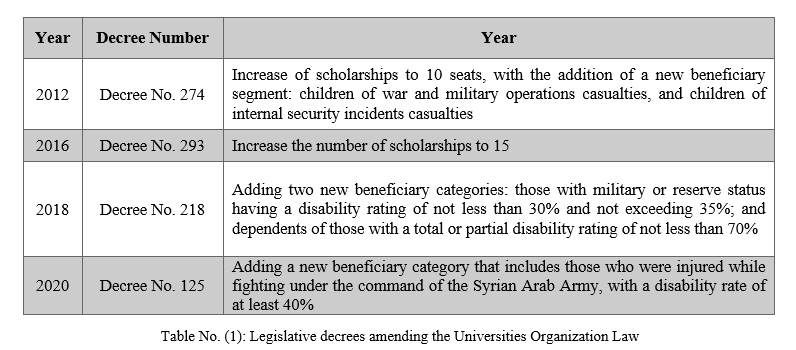
Thus, with the beginnings of the Syrian revolution, the Assad regime's government added new categories of beneficiaries to the scholarship recipients. These included the children of those killed in the Assad forces during the early years of the revolution. The provision of scholarships in universities was directly used as a tool to appease the factions affiliated with the army during the post-2011 years. The concept of university scholarships extended beyond those serving in mandatory military service or volunteering in the army to attract militias that do not belong to the army's structure and the armed forces, enticing them to participate in the regime's battles. This could potentially open the door to including injured individuals from non-Syrian militias in these university scholarships as well.
Structure: Regulation and Formation of Identities
Despite the establishment of the National Union of Syrian Students, its legal, functional, and structural affiliation with the central leadership of the Ba'ath Party has been evident. This is despite the issuance of the Parties Law in 2011, which allows for the establishment of parties and party activities in Syria. ([21]) The dominance of the Ba'ath Party over the state, including governmental institutions and civil society, including the Union and other unions and associations, continued even after the constitutional amendment in 2012 that abolished the provision stating that the Ba'ath Party is the leader of the state and society.
The central leadership of the Ba'ath Party issues the eligibility criteria for candidacy in the Central Council of the Union, as well as the decision to form its executive office (Appendix 1, noting that all current members of the executive office are Ba'ath Party members, except for one member from the Syrian Communist Party, who has the least interaction and appearance on the Union's platforms). Moreover, it is required that candidates for committees and student units be Ba'ath Party members and have their membership confirmed (Appendix 2).
The executive office was restructured in 2020, and the presidency of the Union was changed after stagnation in the position for more than 17 years, during which Ammar Saati remained at the head of the Union without any changes, except for periodic replacements of some names in the executive office. It is worth noting the repetition of names between the last two executive councils. Ammar Saati was promoted to become a member of the central leadership of the Ba'ath Party and the head of the Central Youth Office in the party, ([22]) while Daren Suleiman replaced him as the president of the Union. Daren Suleiman was previously a member of the executive office of the National Union of Syrian Students and the head of the Private Education and Informatics offices.
It is noteworthy that the age requirement is absent from the candidacy conditions for all levels of the Union's bodies, despite the existence of an article stating that senior members have the right to retain their membership for one term after graduation. However, previous members of the executive office continued to hold their positions for years without being enrolled in universities.
The structure of the National Union of Syrian Students is composed of a central council that includes representatives of the Union branches, and an executive office that is elected every five years (Figure 1).
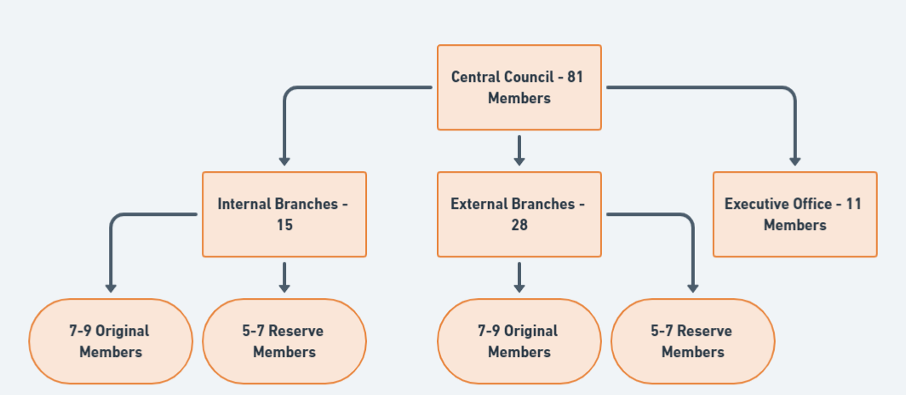
Figure (1): Structure of the National Union of Syrian Students
The internal branches of the Union branch out into student bodies for each college, which are elected every two years, and include student committees for each academic year, as well as a student committee for postgraduate studies. However, they do not have the right to vote in the body's meetings (Figure 2).
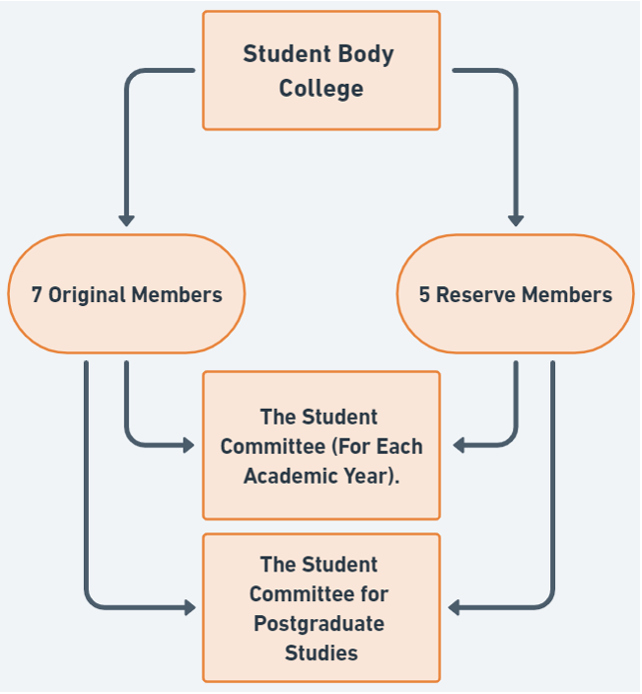
Figure (2): Structure of student bodies in colleges
Elections are held at the level of the Union's internal and external branches to select the representatives of these branches at the general conference, based on varying proportions of seats for each branch, as determined by the executive office. The general conference then generates the Union's central council, which in turn selects the executive office after the approval of the Central Committee in the Ba'ath Party on the chosen names (Figure 3).
Although numerous students participate in elections across colleges, branches, and the entire Union, over the last two terms, the executive office's composition has seen less than a 50% change. Many of those not currently in the executive office, like Bashar Mutlaq, Mohammed Ajil, and Omar al-Aroub, have been given different responsibilities. ([23])
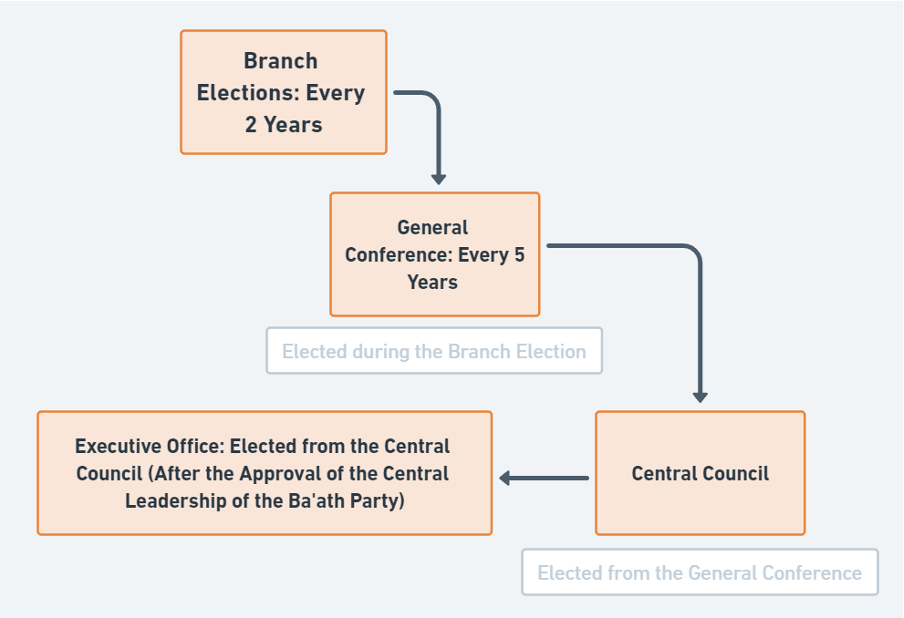
Figure (3): Elections in the National Union of Syrian Students
The Assad regime does not effectively possess any institutes on the ground for qualifying or training young leaders with the aim of exporting them to the upper echelons of the state in the future. Therefore, student organizations at all levels, (starting from the “Ba'ath Vanguards” passing through the “Union of Revolutionary Youth” and ending with the National Union of Syrian Students) represent preparation centers for the Ba'ath cadres, who move after finishing their studies either to lead syndicates or to other positions in the state.
Through these successive institutions, students are groomed on one hand and their loyalty to the ruling authority is ensured on the other, and thus, the idea of elections in the union is more to affirm the chain of loyalty than to be a democratic process among students to choose their representatives entrusted with advocating students' rights in the educational and ministerial councils.
Despite the rigid ring that the regime formed after framing civil society within the policy of the single party; the Syrian revolution and its interactions managed to break this ring in several places, through the defection of individuals who went through the stages of loyalty testing established by the father Assad and sided with the ranks of the revolutionaries.
Universities vary in terms of the composition of branches of the National Union of Syrian Students in them, as branches are primarily divided into 3 types:
1. Branches like Tishreen and Al-Ba'ath display a clear sectarian influence in the Union's makeup.
2. In branches like Aleppo and Damascus, the composition reflects the cities and the balance of power.
3. In branches such as Deir Ezzor and Daraa, the Union's leadership holds minimal influence, and members often hail from the same city.
This variation was clearly reflected in the roles of the Union in the post-2011 phase, in terms of its interaction with the early events, then later its direct role as the central Union leadership or its branches in the governorate, within the context and behavior of the Assad regime in suppressing the revolution, through its official institutions and the auxiliary forces of its army that were established later.
Functional Roles in Service of the Regime
The Ba'ath party was not unaware of the role of civil unrest against military attempts to impose their dominance on the civilian state of the country. Since it took power, civil society has been transformed into a dormant state, starting with the prohibition of societal activities, whether they are service, rights, or sports-related, then framing its institutions within the party's framework, one by one. It managed to make all civil work one of its tools to control society, first, and convey its ideas to successive generations domestically and to foreign countries second.
The Union's roles were not different from the roles of other unions and federations in Syria, as they aligned with Assad's narrative of total societal control. Starting with interacting with the regime's foreign stances regarding regional changes, ending with endorsing its internal decisions on the university and state levels, The National Union of Syrian Students, along with other student-related institutions, was responsible for rallying students in marches that reflect the regime's stance on events such as the invasion of Iraq, the July war in Lebanon, and even its support for Hezbollah under the guise of resistance. This is part of the general picture that the senior Assad had consistently painted; a state that issues decisions and positions that are endorsed by a society that always moves in its favor. The junior Assad continued in this approach, albeit less professionally, due to the change in tools used by those trying to reactivate student civil unrest or otherwise.
After the Syrian regime issued the university regulation law in 2006, one of the law's details was that “the government does not guarantee employment for engineering graduates as was the case before 2006”. This led some students to create sit-ins to protest the decisions, which later expanded to include political demands under the name “Shams Gathering”. This constituted the first semi-organized student movement since Bashar al-Assad took power ([24]). However, the tightly controlled university environment by the triad of teaching and administrative staff and the student union hindered the continuity of this movement, ending it, arresting most participating students and youth. During this period, the roles of the student union were limited to monitoring any movements inside the universities or its associated student housing, with the aim to thwart any movement before it begins. Externally, members of the Union's foreign branches were tasked with following up on the students' news in the resident country, tracking the news of the Syrian community there, maintaining positive relationships with the local student movements in these countries, and establishing ongoing partnerships and events with them.
Since March 2011, universities have significantly interacted with the developments of the popular movement outside their walls. This resulted in an application of the functional and legal structure established after the Ba'ath coup, represented by the local confrontation within the same society's layers or sectors. The direct clash began between students sympathizing with the invaded cities, and the National Union of Syrian Students aiming to neutralize tertiary educational institutions from the popular movement spreading in the country. ([25])
The Union's role began to crystallize on several levels: military, political, and social, within the regime's plan to limit demonstrations away from the governmental, educational, or service buildings. This was later added to the union's narrative by writing: “The Union played a pivotal role in resisting attempts to use university facilities as a means to legitimize the acts of rioting and terrorism that escalated in some Syrian cities” into the introduction of the Union's internal system, which was amended in 2021. ([26])
Repressive Roles and Military Tasks: The Union of Aleppo Students as a Model
The disparity in the reactions of the branches of the National Union of Syrian Students towards the popular movement in the universities was clear, and the military role emerged as one of the roles consistent with the military and security solution of the Ba'ath regime. This was particularly prominent in the University of Aleppo, as most of the Union was composed of the children of Idlib and the countryside of Aleppo, making it difficult for them to confront the movement violently right away. This forced the security branches in the city to gradually escalate violence, by arming the Union students with melee weapons (Sticks - Crowbars - Batons) and giving them the authority to withdraw the ID of students participating in the university demonstrations for later security pursuit. The Union's decision to refrain from excessive violence was in line with the will of the party's branch in the university, as the branch secretary, Abdul Aziz Al-Hassan, refused the security solution and violence in the university, and did not allow the security branches to raid the university extensively, leading to a change in the leadership of the party branch, and Abdul Qadir Al-Hariri taking over, who adopted the security will in excessive violence against any student movement opposing the authority at the University of Aleppo, ([27]) in addition to his decision to dismiss students who participated in the university demonstrations. ([28])
The Union's branch at the University of Aleppo could not stop the student movement at the university, which prompted the regime to search for more organized, effective, and sustainable tools. This led to the formation of the Ba'ath Brigades in 2012 from university students, with their roles lying in two axes:
● Security axis to control the universities with all forms of violence ([29]), and a
● Military axis by participating as auxiliary forces alongside the army in siege operations or battles.
However, later, the Ba'ath Brigades were no longer limited to university students but included party members of different ages. With the escalating role of the Union within the Ba'ath Brigades, sanctions were imposed on Amar Sa'ati, ([30]) who was responsible for the Ba'ath Brigades by the US, ([31]) as part of punishing the leaders of military factions participating in battles and committing massacres. ([32])
As for the less organized military roles, arming the students of the National Union of Syrian Students was present in other branches like the University of Damascus, Al-Baath University, and Tishreen University, but on an individual level and not collectively. The students who were armed were chosen based on loyalties that depend on geographical or sectarian affiliation, or cumulative trust that depends on the extent of services provided to the security branches. This arming aimed to end any movement in the universities by exaggerating the reaction towards participating students to deter their peers from repeating the movement, ([33]) in addition to that, several branches of the Union used places in university housing units, like the University of Aleppo, for arresting and torturing demonstrating students captured by them, before being transferred to the security branches like Damascus and Tishreen universities, where several students were killed under torture after their arrest by the Union members in their universities and their delivery to the security branches.([34])
On a smaller scale of military action, the Union was responsible for inspecting students at the entrances to universities and university housing, and it was the one issuing updates and entrance conditions to universities, coinciding with developments in the surrounding scene at the university. ([35])
This direct arming aimed to stop any movement in Syrian universities without waiting for security or military intervention to control the universities, and the Union members were given all the powers to achieve that, ([36]) along with pursuing activists in the universities with the aim of arresting them. The matter even extended to pursuing professors within universities and arresting them if they have any roles or activities opposing the regime, as happened with Mohammed al-Ahmad, a professor in the French Language Department at Tishreen University.([37])
The Union's military work continued in an organized manner within the Ba'ath Brigades until the present time; centers for the brigades were established in some universities like Aleppo, in addition to centers in all cities, and its social activities are mostly shared with the National Union of Syrian Students, as part of the regime's government plan to export figures from the Ba'ath Brigades as societal and youth faces in the next phase.([38])
Political Marketing of the Regime's Narrative
The National Union of Syrian Students has long served as the primary training hub, grooming individuals for key roles within the Assad regime post their university graduation. This includes positions such as ministers, ambassadors, city party branch leaders, and members of the People's Council. The Union's tradition of molding its members (especially those in the executive office or as Union heads) to become prominent figures in politics and society wasn't a recent strategy introduced by Bashar al-Assad. Instead, it's been a foundational goal since the Union's inception, underscoring its political influence over the past four decades. Notably, Union executive members from the eighties and nineties, like Haitham Al-Duaihi, Wafaa Sunain, Faisal Al-Mikdad, and Hamid Hassan, have maintained significant roles within the state, even post the revolution's onset.([39])
The National Union of Syrian Students was one of the first arms of the Assad regime to interact with the internal developments in Syria, through its internal and external activities. As the regime launched its series of “national dialogues,” the Union was one of the organizations arranging the National Dialogue Conference in July 2011, which was directly funded by the Syria Trust for Development, owned by Asma al-Assad. ([40])
This was followed by a series of dialogues in Syrian universities, aimed at portraying the popular movement as part of a conspiracy against Syria, and that those who participate in it will be part of the war on Syria, and that the only place for change is to participate in these dialogues spread across cities under the supervision and management of the Union.([41]) The Union's interaction with changes continued,([42]) whether at the level of events, or even reactions to demands for constitutional and governmental reform in Syria, in line with the security and military narrative of the Assad regime that it is facing terrorist groups whose goal is to undermine the stability and unity of the country.([43])
The dialogue sessions supervised by the Union continued until the date of preparing this study, within three main axes:
1. Service discussions in Syria as a whole, in terms of organizing universities and even the “formal” activities or campaigns in state institutions, such as combating corruption, in addition to interacting with local administration elections. ([44])
2. The regime's narrative and producing tools to market it internally and externally. ([45])
3. Regarding international changes, whether at the level of the behavior of states towards the Syrian regime, from sanctions or positions, or even ongoing events such as the Russian invasion of Ukraine. ([46])
The Union is now attempting to circumvent the sanctions imposed on the regime. Most western sanctions have been imposed on the regime's ministers, security and military leaders, or individuals involved in economic networks related to it, or even on former members of the Union, like Ammar Saati, who was later promoted. However, sanctions have not been imposed on other Union members despite their involvement in crimes against students, such as Omar Aroub.([47])
Despite the sanctions imposed on it, the Union continues to participate in international conferences, like the Education Summit,([48]) and the International Student Exchange Conference,([49]) Despite the sanctions imposed on the Assad regime.
Social Roles Consistent with the Dynamics of the Regime
The role of the National Union of Syrian Students in supporting the Assad regime post-revolution was not limited to universities and their affiliated institutions. Instead, it also took on roles outside the university that included a social dimension.
After 2011, the regime was keen to establish several of its institutions and associations, either involved in aiding its wounded, promoting it within the community, or even providing the institutions established by regime figures with human resources. An example of this is the agreement signed by the National Union of Syrian Students with the “Wathiqat Watan” project owned by Bouthaina Shaaban, the media advisor to Bashar al-Assad. This project is concerned with documenting events in Syria based on the regime's perspective.([50])
The Union entered into an agreement with a project aimed at involving students in the oral documentation of Syrian events. Additionally, they initiated student competitions to reinforce the regime's narrative both within the student community and the broader society.
Furthermore, as the regime faced increasing casualties and injuries from its confrontations, the Union stepped in as a supplementary institution for social support. They collaborated with the 'Jarih al-Watan' project, overseen by the Ministry of Defense. This partnership led to the formation of a joint committee, headed by Mahmoud al-Shawa, the Deputy Minister of Defense.([51])
The Union turned to establishing subsidiary teams that are not organizationally subordinate to the Union, but the heads of these teams are members of the Union. The role of these teams was relief and social, as part of the regime's attempt to form relief nuclei capable of raising funds, or even reaching all segments of society, and monopolizing student work, even at the level of specializations through initiatives related to university branches, such as the voluntary medical staff headed by the president of the Union at the University of Aleppo.([52])
Summary Conclusions
To grasp the intricacies of Assad's regime, it's vital to see how it seamlessly merges its robust military and security measures with subtler strategies, all designed to dominate the nation and its people. Within this context, the regime has strategically channeled student activities, adapting relevant laws in response to both domestic and international shifts. Notably, since 2011, there have been no significant disruptions or splits at the union's upper echelons. Once Union members transition out, the regime integrates them into various state roles, assigning them to internal political, administrative, or foreign diplomatic duties.
The legal frameworks governing student activities mirror the regime's intent, framing public space and harnessing it as a series of tools to sustain and establish its rule. Post-revolution, the regime seeks to placate its allied factions by legally granting them scholarships, regardless of their military service status or Syrian nationality. Concurrently, the union's influence has expanded since the Ba'ath takeover, now spanning military, religious, and societal domains, beyond its primary role.
The Union also possesses a clear administrative structure within its internal, ostensibly non-party system. Still, administratively, the Union follows the central youth office in the Ba'ath Party. Branch presidents and office members are chosen based on university significance, with selections influenced by regional, tribal, and ethnic factors. Yet, genuine democratic elections and position rotations have been conspicuously absent for over half a century since the Union's inception.
On an international level, the union is not merely a tool to control universities, their students, and related facilities. Instead, it plays a critical part in rehabilitating and cleaning up the image of the regime through students who study at universities and participate in international conferences and events, both political and social. These students also spy on their peers in those countries and promote the regime's narrative about ongoing events in the country.
In conclusion, Assad regime institutions align in their importance for controlling society and preventing any attempts for change. An essential part of dismantling these institutions is understanding them, their dynamics, tools, the spaces of their roles, and their impact. The National Union of Syrian Students is among the most crucial, and dismantling these institutions' structure is an initial step in reducing their effectiveness externally and detaching student work in Syria from the Ba'ath regime. This move is part of a vision to achieve a peaceful transition for all state institutions and civil society and apply transitional justice.
Appendix 1

Appendix 2
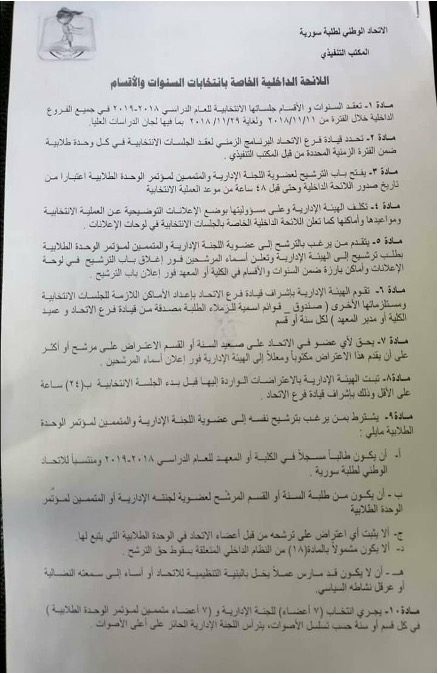
([1]) El Amine, A. (2019). Governance of Higher Education in the Arab World and the Case of Tunisia. International Higher Education, (97), 7-9. https://bit.ly/3JUJfSs
([2]) Aljasem, A. (2021). In the shadow of the state: The rise of Kata’ib al-Baath at Aleppo University after 2011. Journal of Perpetrator Research, 3(2), 87-113. https://bit.ly/3FOBg7Q
([3]) Watenpaugh, K. D., Fricke, A. L., & King, J. R. (2014). We will stop here and go no further. Syrian University Students and Scholars in Turkey. Institute of International Education. https://bit.ly/3veuOlN
([4]) The term 'Sheikh al-Kar' refers to an ancient position during the Ottoman Empire era. In every craft or trade, there was a 'Sheikh al-Kar' who ruled in disputes and was responsible for the workers in that specific profession.
([5]) Lebanese University, Legal Informatics Center, Law of Associations, issued on August 3, 1909 https://bit.ly/3Mb1rdw
([6]) It was established in 1921 by several national figures, the most prominent of which is Fares Khoury", the history of the Bar Association in Syria, Syria News website, January 2015 https://bit.ly/3PQHybM
([7]) "Its role became clearly prominent after the establishment of the cement factory in Damascus in 1928" - Abdullah Hanna, The Labor Movement in Syria and Lebanon 1900-1945, Dar Damascus, 1973.
([8]) Article 17: Syrians have the right to form associations and to join them, provided that their aim is not prohibited by law, Syrian Constitution of 1950 https://bit.ly/3Q8asEx
([9]) The Syrian Arab Republic, Ministry of Social Affairs and Labor, Law of Associations and Private Institutions No. /93/ of the year 1958 https://bit.ly/3HYENmM
([10])Contemporary Syrian History, Decree Establishing the National Union of Syrian Students, Legislative Decree No. 130 of 1966 https://bit.ly/3vdTQ4u
([11])Contemporary Syrian History, Decree Establishing the Revolution Youth Union, Legislative Decree No. 23 of 1970 https://bit.ly/3FOAqYA
([13]) Syrian Parliament's official website, University Regulation Law NO. 6 of 2006 https://bit.ly/3VvqYzg
([14]) Syrian Parliament's official website, University Regulation Law NO. 1 of 1975 https://bit.ly/3jvuyMB
([15]) Syrian Ministry of Education website, Decision NO. 252 of 2015, related to the formation of the Higher Education Budget Committee https://bit.ly/3PSoXvY
([16]) This refers to studying in public universities through the competitions conducted by the Ministry of Higher Education.
([17]) Clause B - Article 196 of the Executive Regulations for the University Organization Law of 2006:
The self-resources mentioned in paragraph (A) are placed in a separate account in the Commercial Bank of Syria according to their receipt in Syrian pounds or foreign currencies. The disbursement from this account should be according to the following priority order:
1- A- The goals related to the plans and programs for modernizing and developing higher education and promoting universities, which are determined by the Minister through a decision coordinated with the Minister of Finance. These goals should not be less than 60% of the total self-resources, and the disbursement is done by the University president through official bonds.
B- Allocating a percentage that does not exceed 40% of the investment allowances in restaurants, forums, canteens, and kiosks. The percentage is calculated annually by a decision from the Minister in agreement with the Minister of Finance, which determines the disbursement aspects and the benefiting entities.
([18])Higher Education Council website, Decision NO. 274 of 2011 https://bit.ly/3GgluD9
([19]) Syrian Parliament's official website, Legislative Decree NO. 36 of 2001 https://bit.ly/3VG5QGR
([20]) Article 116- It is not permissible to accept any student on a personal basis without adhering to the order of success scores and other standards set by the Higher Education Council, except as follows:
1- The children of the holders of the Hero Medal of the Syrian Arab Republic are accepted in the branch they wish to join according to the type of secondary school certificate.
2- A: A number not exceeding five students in each college or department or specialization from the children or siblings or spouses of those who were martyred in the war or were martyred in the Palestinian armed struggle or were martyred due to their official duties. The Higher Education Council determines the cases of martyrdom due to official duties, and acceptance is through competition among them by a decision of the minister according to the order of success in the secondary certificate and according to the standards set by the Higher Education Council.
([21]) Syrian Parliament's official website, Legislative Decree NO. 100 of 2011 https://bit.ly/3PW2Rsq
([22]) The Central Youth Office in the Party is responsible for the Vanguard of the Baath, the National Union of Syrian Students, the Union of Revolutionary Youth, the General Sports Federation, and the Baath Brigades.
([23]) Refer to:Bashar Mutlaq: Chosen to head the special organizing committee for participants," in the affirmation of the committee to discuss the current constitution and its tasks in the Syrian National Dialogue Conference in Sochi, SANA news agency https://bit.ly/3Gls7oH. Current member of the People's Council, National Media Agency, Names of the new Syrian People's Council members 2020 https://bit.ly/3vhJiRE
Mohammed Ojail: Current member of the People's Council, previous reference.
Omar Al-Aroub: Former member of the People's Council for the legislative term 2016-2020 https://bit.ly/3jvKU82 , head of the regime's Olympic mission to the Tokyo 2020 Olympics, current Vice President of the General Sports Federation, and Deputy Commander of the "Ba'ath Brigades".
([24]) Experiences from the Political Activity of Youth Before and During the Revolution", Syria Freedom website, 16/02/2016 https://bit.ly/3WFswZU
([25]) Storming the International University of Science and Technology https://www.youtube.com/watch?v=rXzr2HtsU40
([27]) From an interview conducted with researcher Ali Al-Jasem, a former member of the Aleppo branch of the National Union of Syrian Students.
([28]) Aleppo University dismisses students who participated in protests against the regime, Zaman Al Wasl, 15/01/2013 https://shorturl.at/awEH8
([29]) Unit number 20 in the university city of Aleppo was converted into a temporary detention center supervised by the Ba'ath Brigades – from the previous interview with Ali Al-Jasem.
([30]) Ammar Sa'ati became responsible for all student institutions within his position as head of the Central Youth Office in the Central Committee of the Ba'ath Party, in addition to the Ba'ath Brigades.
([31]) U.S. DEPARTMENT OF THE TREASURY, Treasury Sanctions Senior Syrian Government Officials,Augustus 2020 https://bit.ly/3nqHAK9
([32]) The current commander of the Ba'ath Brigades is Bassem Sudan, who was the vice president of the National Union of Syrian Students until 2020.
([33]) Storming the International University of Science and Technology, November 2011 https://bit.ly/3QaZRZv
([34]) Ayham Ghazoul's death under torture after his arrest by Union members at Damascus University - An investigation by Human Rights Watch, 'If the Dead Could Speak', December 2015 https://bit.ly/3B0v1fx
([35]) The National Union of Syrian Students tightens security measures at Tishreen University https://bit.ly/3XIMYsM
([36]) Security forces, along with members of the Damascus branch of the Union, stormed the Private Arab University following protests there, and students were assaulted in collaboration with Union branch members at the university https://bit.ly/3gLjREs
([37]) He was arrested, and the National Union issued a statement regarding him, confirming his suspension from teaching and his arrest, December 2018 https://bit.ly/3iviQBf
([38])The regime promotes “Al-Ba'ath Brigades” as a front for Syrian youth. What is the relationship with the Chinese Communist Party?, Syria TV, 13/10/2022 https://bit.ly/3gMZ3wD
([39]) Haitham Al-Duaihi: Former president of the National Union of Syrian Students from 1976 until 2000, Minister of Presidential Affairs 2000-2003, former member of the People's Council, Deputy Chairman of the Central Committee for People's Reconciliation 2014.
Wafaa Sunain: Former member of the Union's Executive Office, Director of Planning and Training in the Ministry of Education, Deputy Minister of Education 2014.
Faisal Al-Mikdad: President of the Union branch at Damascus University - Member of the Executive Office of the Student Union 1981 - current Minister of Foreign Affairs.
Hamid Hassan: Syrian Ambassador to Tehran 2006 - Deputy Minister of Foreign Affairs and Expatriates - current member of the People's Council.
([41]) Dialogue sessions in Raqqa city, July 2011. https://bit.ly/3UvJNC9
([42]) A pro-government march in Aleppo organized by the National Union of Syrian Students and the Union of Revolutionary Youth, June 2011. https://bit.ly/3EKAo3K
([43])The pages of the Syrian Student Union launched a widespread campaign against those calling for the abolition of Article Eight of the Constitution, which states that the Ba'ath Party is the leading party of the state and society, July 2011 https://bit.ly/3AVskfb + https://bit.ly/3GWu77O
([44]) The Union launched a series of dialogues as part of the "First Neighbor" initiative, August 2022. https://bit.ly/3t0EpLO
([45]) A meeting for active students in dialogue sessions with Bashar al-Assad. https://bit.ly/3GVSTF0
([46]) A dialogue session held by the National Union titled (The conflict in Ukraine and its international and Syrian implications), April 2022. https://bit.ly/3tXPrSB
([48]) The National Union of Syrian Students' page on Facebook https://bit.ly/3g40Ahr
([49]) The National Union of Syrian Students' page on Facebook https://bit.ly/3Vwv2Ql
([50]) 'Wathiqat Watan' Website, Who We Are? https://bit.ly/3jwK6zB
([51]) Signing of a cooperation agreement between 'Jarih al-Watan' Project and the National Union of Syrian Students, August 2022. https://bit.ly/3Xjg2XQ
([52]) The National Union of Syrian Students - Union branch at Aleppo University's Facebook page. https://shorturl.at/DLX78
Monthly Briefing on The Events of The Syrian Scene - August 2023
Executive Summary
This report provides an overview of the key events in Syria during the month of August 2023, focusing on political, security, and economic developments. It examines the developments at different levels.
- Security and Military Sector: In Deir Ezzor, the security situation has deteriorated significantly following the disbandment of the “Deir Ezzor Military Council” and the subsequent arrest of its leaders by the Syrian Democratic Forces “SDF”. This has sparked intense conflicts between the SDF and local Arab tribes, who are calling for the creation of a genuine local government that truly represents the region's inhabitants.
- Political Sector: Civilian demonstrations escalated in the province of As-Suwayda, with people asking for political changes based on a specific Security Council Resolution /2254/ after the regime's failure to achieve popular demands for twelve years.
- Economic Sector: The Regime's efforts to alleviate the severe economic crisis by raising the salaries of workers have proven to be ineffective. Despite the increase in wages, the cost of essential goods has more than doubled, making the monthly average living cost for a family of five in Syria exceed /10.3/ million Syrian Pounds.
Frustration and Resistance: Emerging from the Regime's Policies
Bashar al-Assad has made the decision to replace the governor of Tartous, “Abdel Halim Khalil”, with the retired Brigadier General “Firas Ahmed al-Hamid”. This move is seen as an effort to quell the growing dissatisfaction among civilians due to bad living conditions in Tartous.
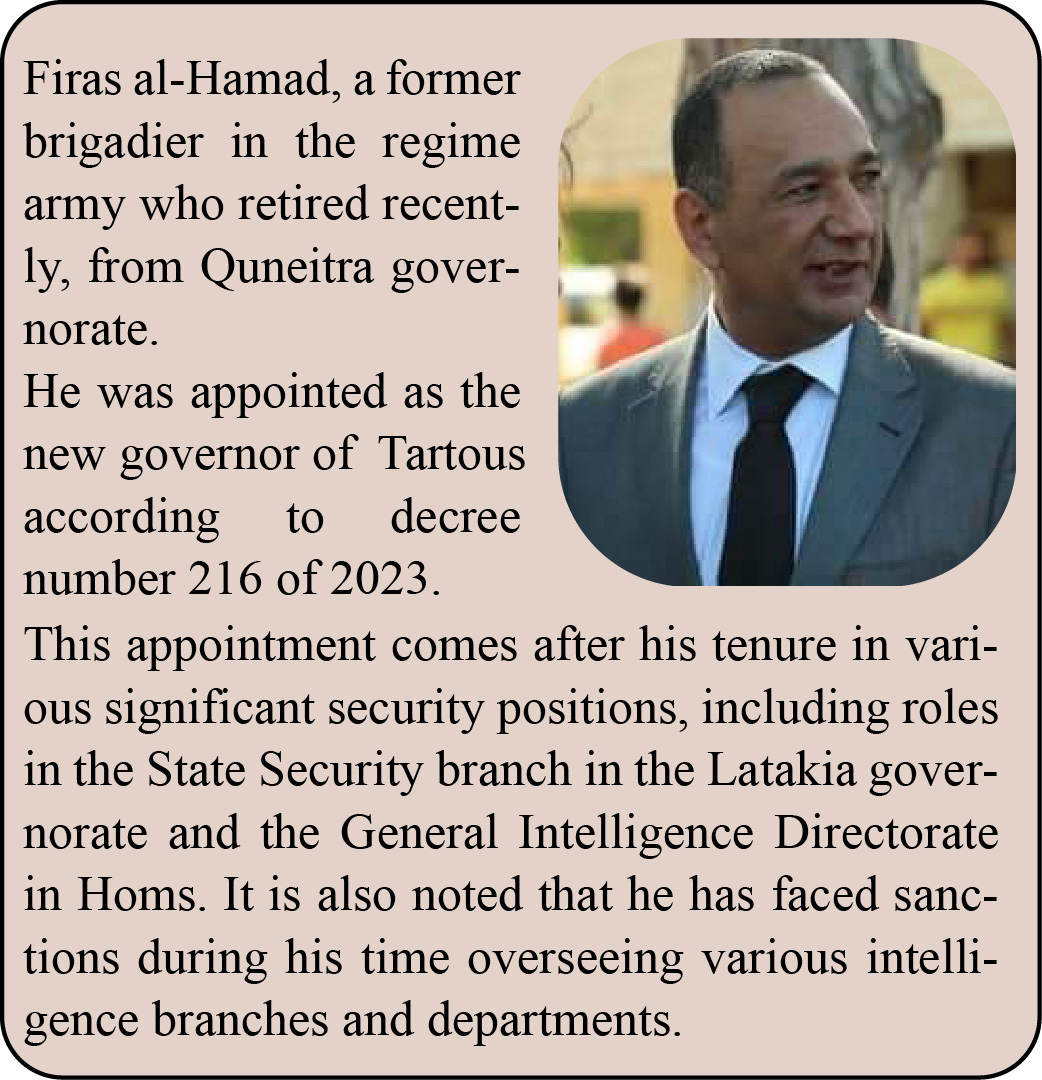
In August 2023, the protests against the poor economic conditions intensified with a higher number of participants in As-Suwayda province. The scope of these protests has significantly expanded, spreading to /48/ distinct areas, a substantial increase from only /3/ areas during previous demonstrations.
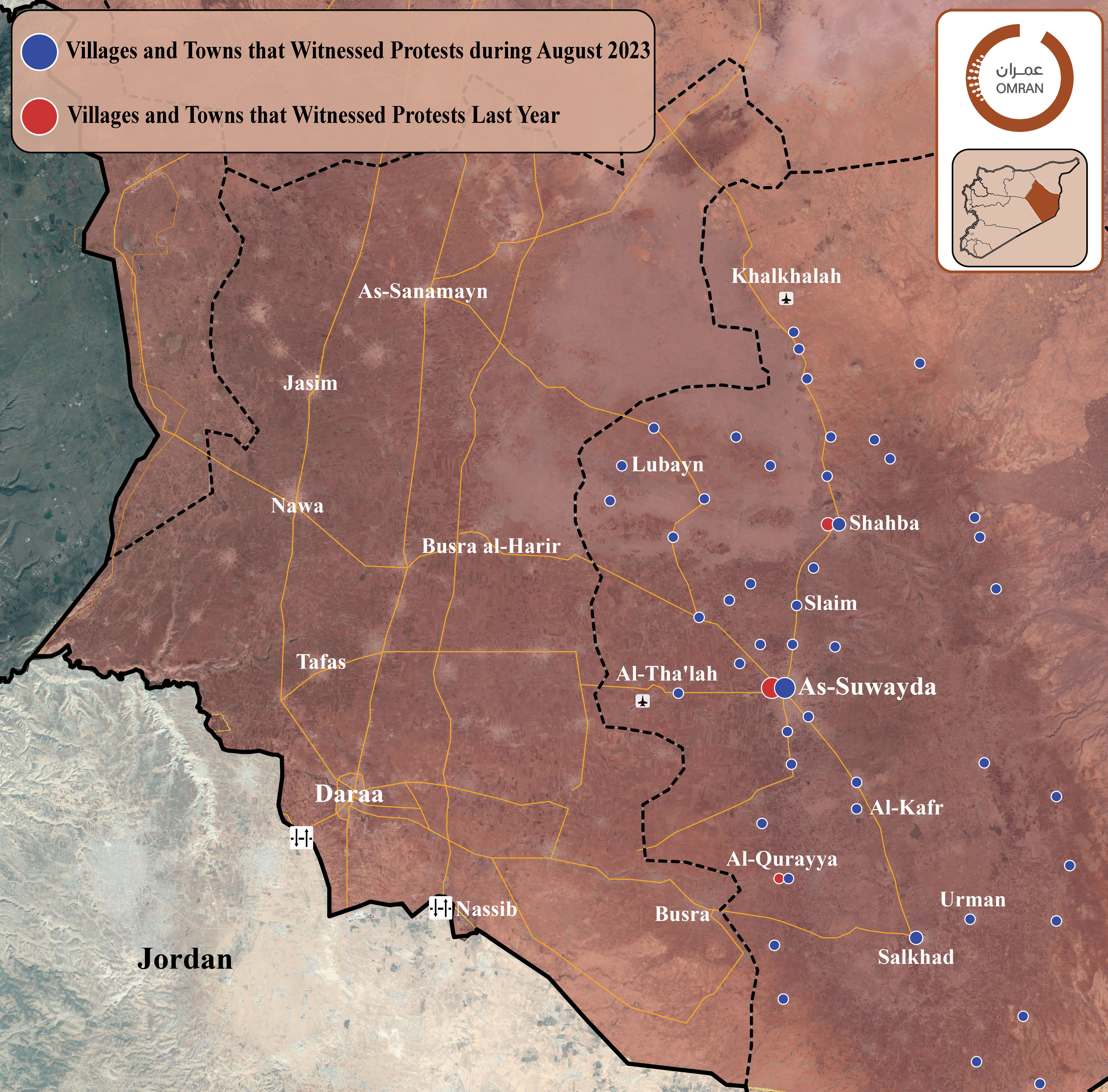
Map (1): Protest points in As-Suwayda governorate during August 2023
If the protest in as-Suwayda province evolved, we might see the Regime adapting different tactics in dealing with these protests such as, using local gangs in the city to incite violence or even assassinate key figures in the protest movement, particularly if it begins to threaten the interests of the regime and its allies, including potential disruptions to drug trafficking routes (primarily Captagon).
In August, the head of the National Coalition of Syrian “SOC” received a letter from the French Foreign Minister. The letter stated France's belief in the need for political change in Syria and their goal to hold war criminals responsible. Also in August, Bader Jamous was chosen again as the president of the Syrian Negotiations Commission for a second term.
Syria's Shifting Sands: The Impact of Recent Security and Military Events on Territorial Control
During 2023, the Regime held-areas have seen a rise in IEDs attacks aimed at the regime military's and security forces, during August 2023 two IED's attacks were recorded, one in the city of al-Moadamyeh and the other attack was at al-Quneitra province, the rise in IED attacks is a clear indication of the regime's growing weakness of its security capabilities, after becoming more reliant on untrained foreign militias on one hand, and the ongoing failure in limited ISIS cells attacks in 2023 on the other hand.
In the Opposition held-areas, in southern Idlib, specifically in the northwest region of Jabal al-Zawiya, ongoing battles have been reported between the “al-Fateh al-Mubin” opposition factions and the regime forces alongside their allied militias. The conflict escalated after the opposition took control of the “Milaja” village and other strategic points. In response, Russian warplanes-initiated airstrikes to aid the regime forces in recapturing the lost territories. The clashes over three days resulted in numerous casualties, including dozens from the regime forces and 7 opposition fighters.
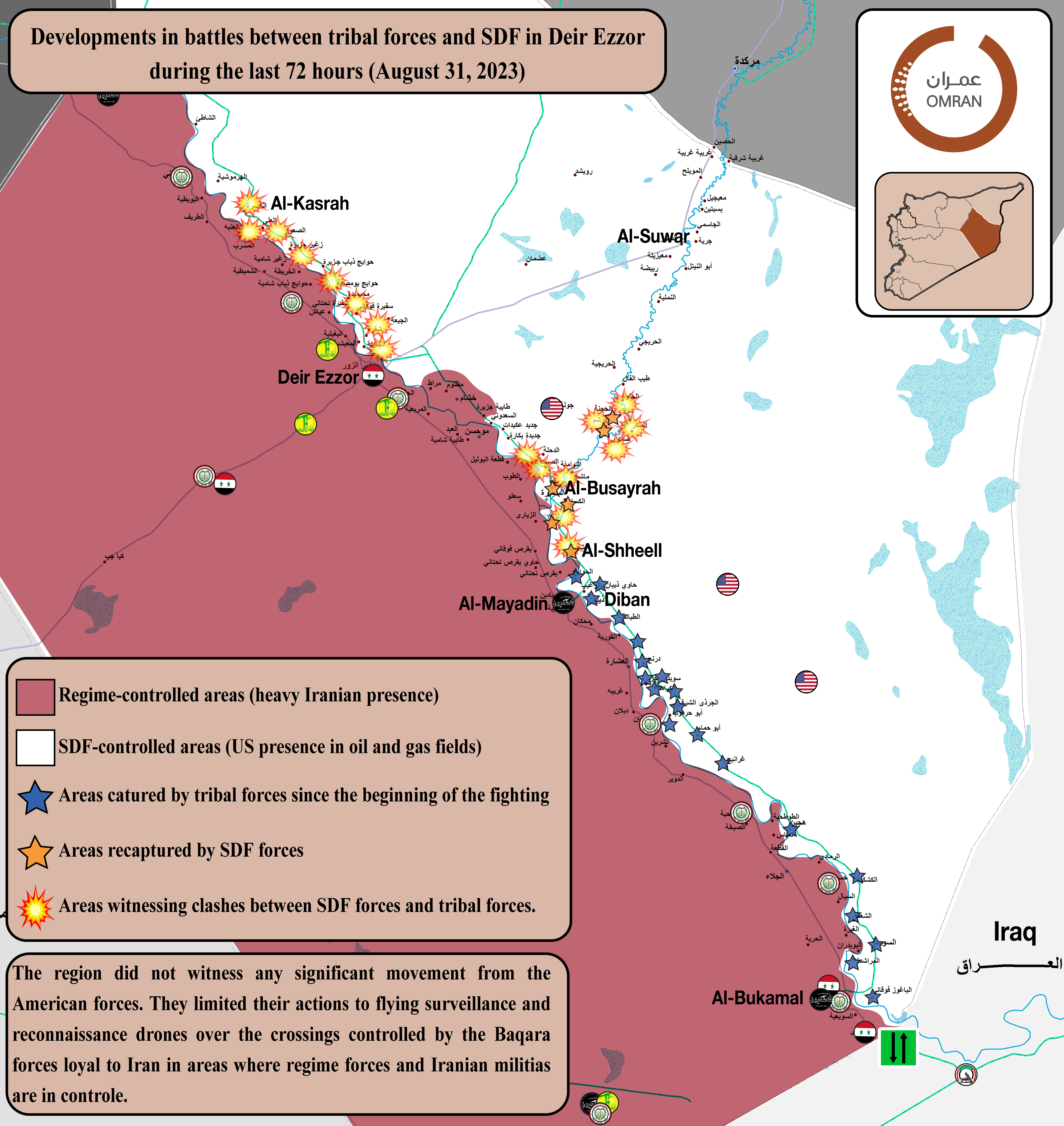
Map(2):Developments in battles between tribal forces and SDF in Deir Ezzor (August 31.2023)
In the SDF held-areas, in Deir Ezzor, tensions increased between the SDF and tribal forces following the arrest of the Deir Ezzor Military Council commander, “Ahmed al-Khabil”, and several other leaders of the council by the SDF. The situation worsened as the SDF implemented a security policy to manage the backlash, which triggered further violence. The aggressive stance of the SDF towards civilian demonstrators spurred other tribes, including al-Akidat clan, to join the fight, demanding redress for the grievances of the Deir Ezzor populace and the removal of Kurdistan Workers' Party “PKK” leaders from the region. This situation poses a significant challenge to the “Autonomous Administration of North and East Syria” project and its influence over the area.
Discontent and Migration on the Rise as Syria Grapples with Economic Crises
Regime Held-Areas
Bashar al-Assad approved a decree to double the salaries of public sector workers, both civilian and military. This was followed by a 50% bonus for certain groups. However, the regime also increased fuel prices and reduced subsidies on drinking water by up to 400%, leading to a surge in the cost of living, with the average family now needing over /10.3/ million Syrian pounds to get by, according to Qasioun newspaper. These measures, aimed at covering the salary increase, have resulted in a continuous devaluation of the Syrian pound and increased poverty.
On another note, the regime will have to import around two million tons of wheat to meet the country's needs, as the local season's won't exceed /800,000/ tons, far below the required three million tons. Meanwhile, to foster ties with Saudi Arabia, the regime granted licenses to two Saudi-owned companies to invest in Syria's phosphate, fertilizer, and cement sectors. However, Saudi Arabia has imposed restrictions on Syrian trucks entering its territory, causing delays at the Nasib crossing.
Moreover, there has been a significant increase in the migration of traders, especially from Aleppo and Damascus, with some transferring substantial gold reserves abroad, highlighting the deepening economic crisis.
SDF Held-Areas
The “Autonomous Administration of North and East Syria” has doubled the salaries of its civilian and military employees, setting the minimum wage at /1,040,000/ Syrian pounds and the maximum at /8,222,000/ Syrian pounds. They also increased the price of heating diesel and allocated /300/ liters per household for the upcoming winter.
In terms of early recovery projects, 90% of the “Ambara” road project, linking al-Qamishli city to the M4 international road, has been completed with a 2023 budget of around $/794,633/.
To regulate economic activities, two laws were enacted:
- One governing exchange and transfer operations, setting the minimum capital for exchange companies at $/500,000/ and for exchange offices at $/50,000/.
- And another regulating the trade and manufacture of precious metals, outlining licensing procedures and prohibiting unlicensed operations. The administration also approved a draft law comprising 66 articles to combat money laundering.
Opposition Held-Areas
In northwest Syria, the “Salvation Government” raised the prices of gasoline and domestic gas following a two-week shortage in its controlled areas. To foster investment, the “Syrian Interim Government” initiated discussions with local entities to organize an investment conference aimed at enhancing the investment environment in northern Syria. A memorandum of understanding was signed with various stakeholders to foster cooperation and prepare for the conference.
Meanwhile, the electricity crisis is escalating in rural Aleppo, with “Ak Energy” hiking electricity prices, sparking public outrage and protests in front of the company’s headquarters in Azaz. Local councils are considering new contracts with alternative energy providers to address the issue.
In terms of early recovery, projects are underway in rural Aleppo and Idlib, including housing projects and road expansions to improve infrastructure. Various organizations are working on these initiatives to facilitate better living conditions and connectivity in the region.
